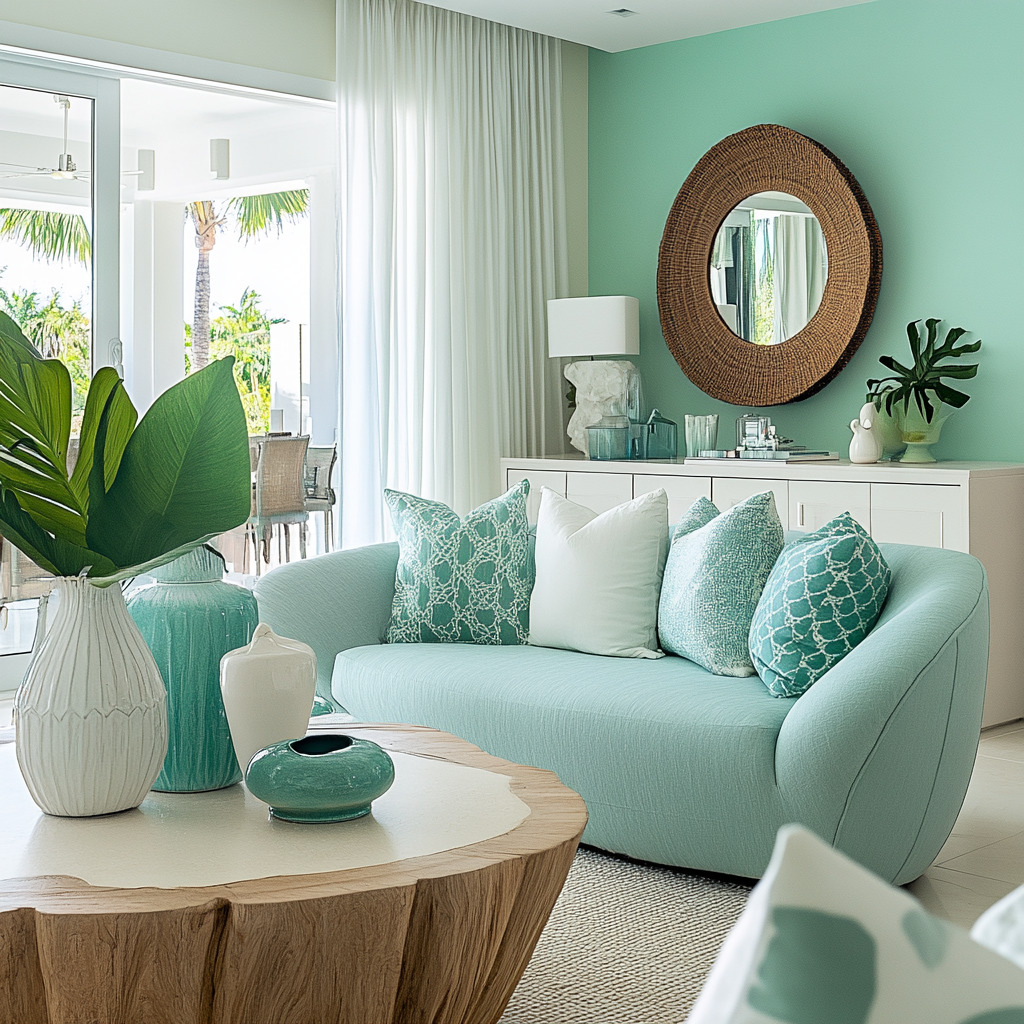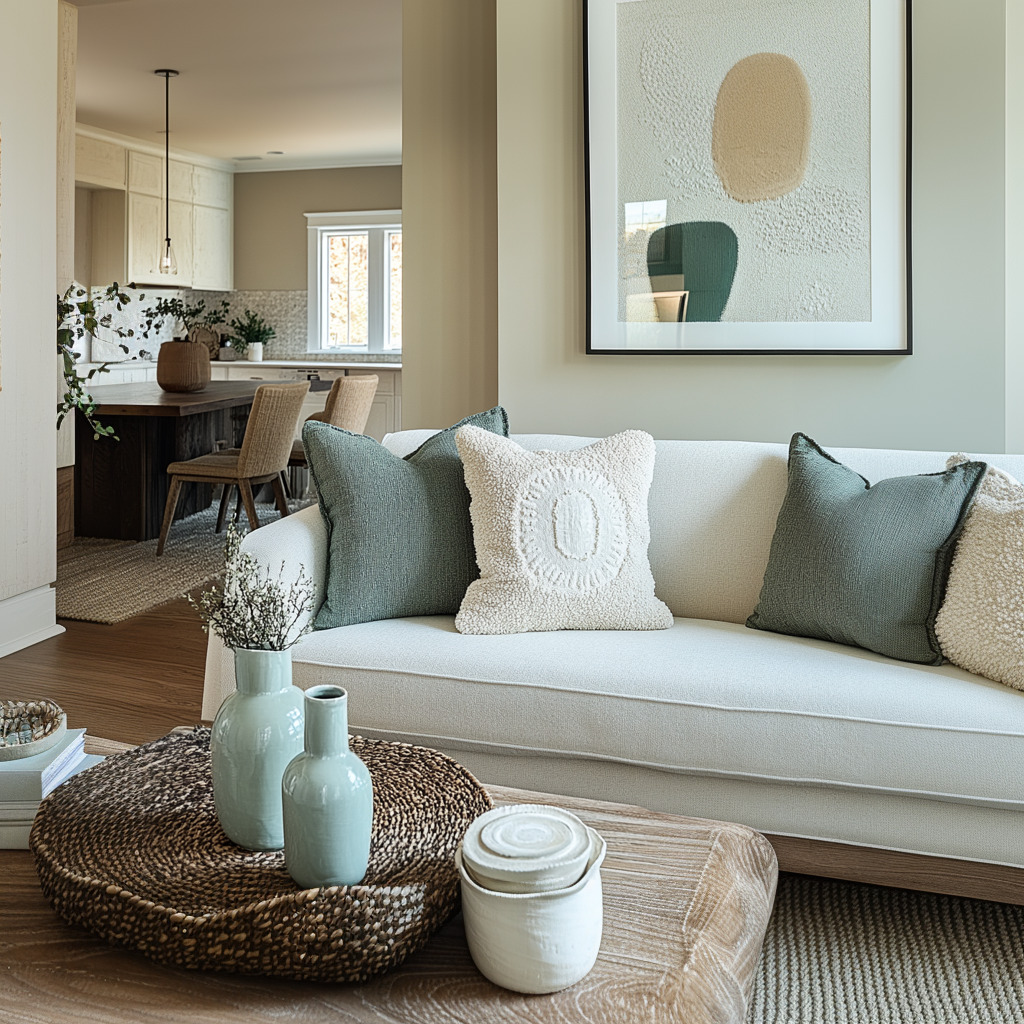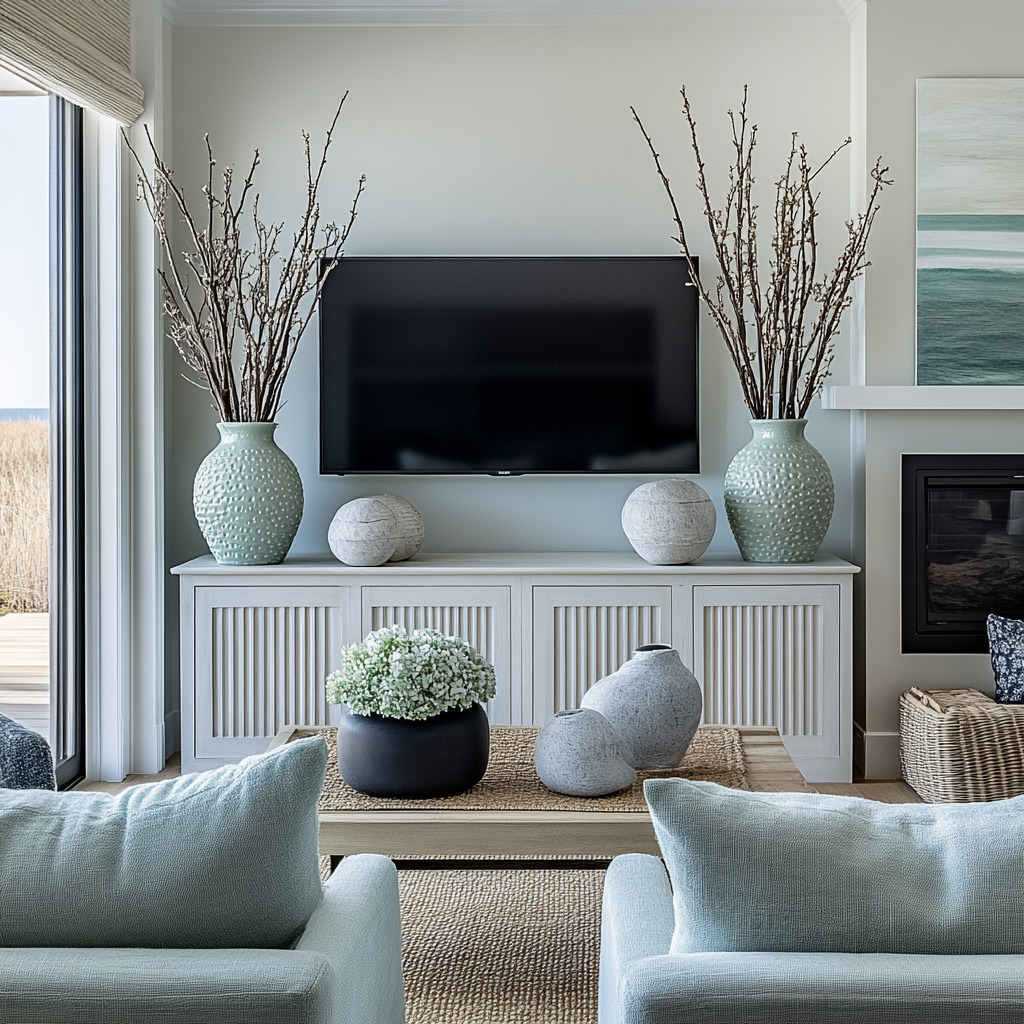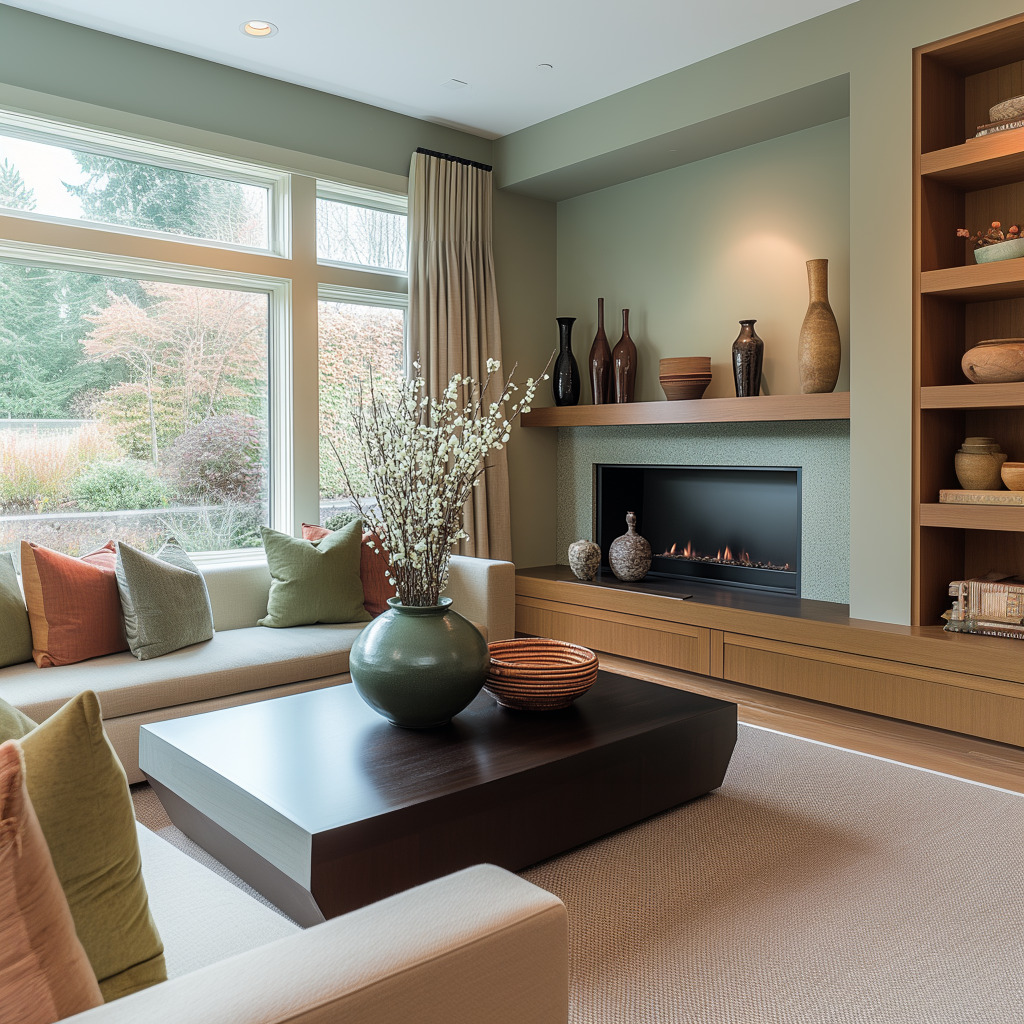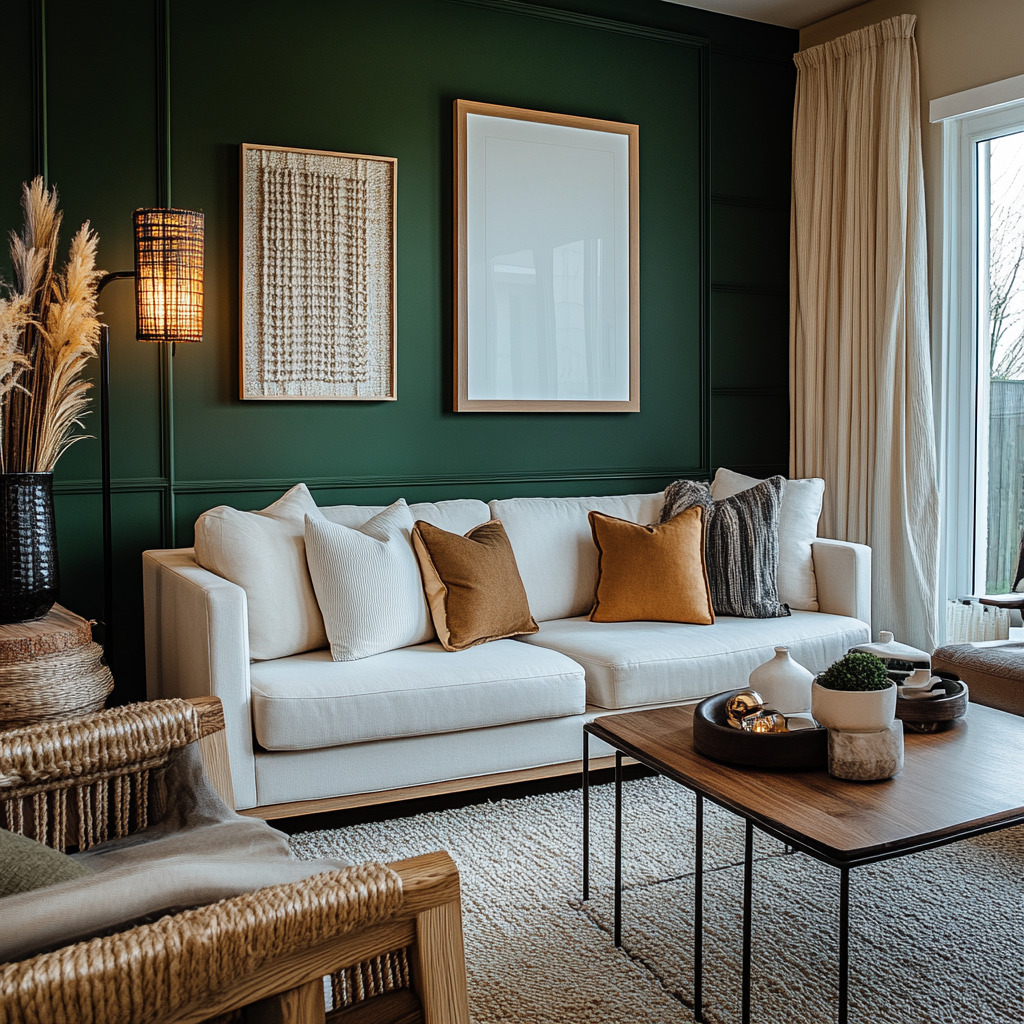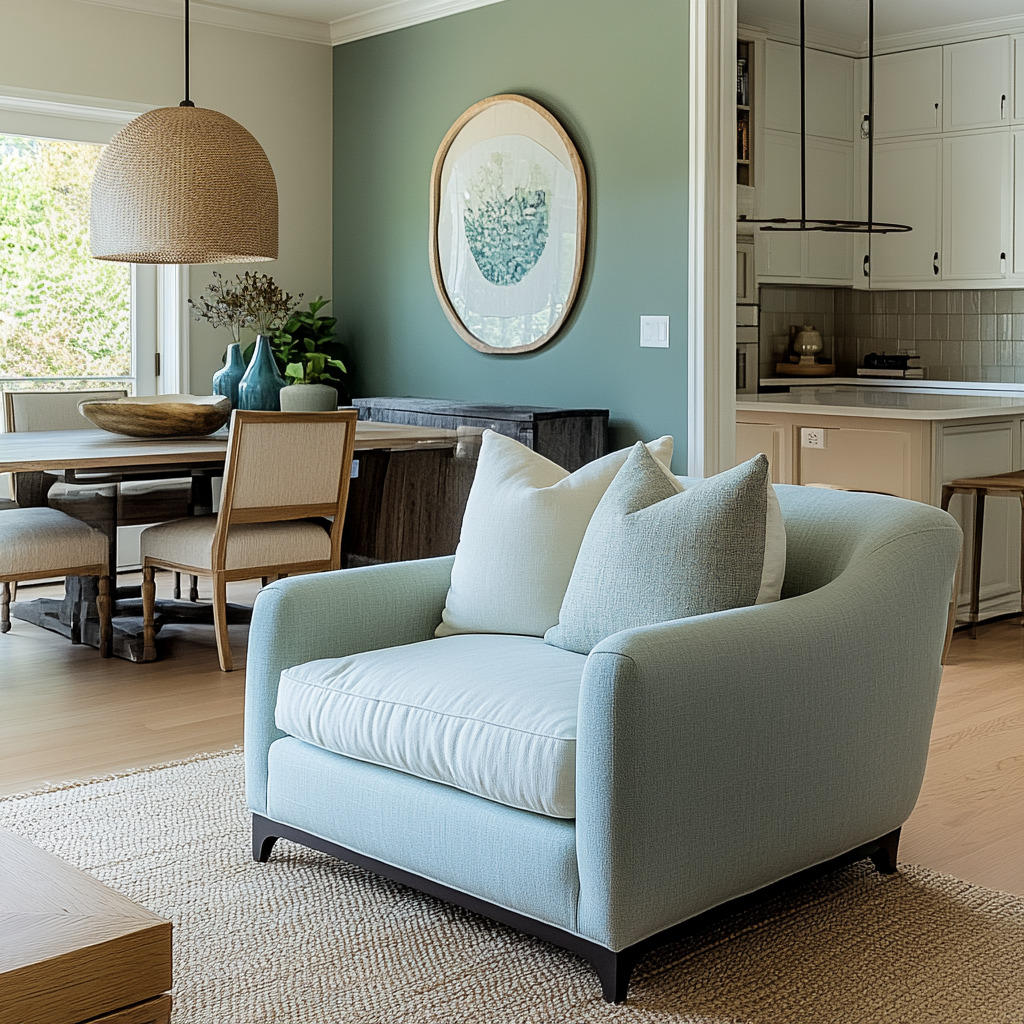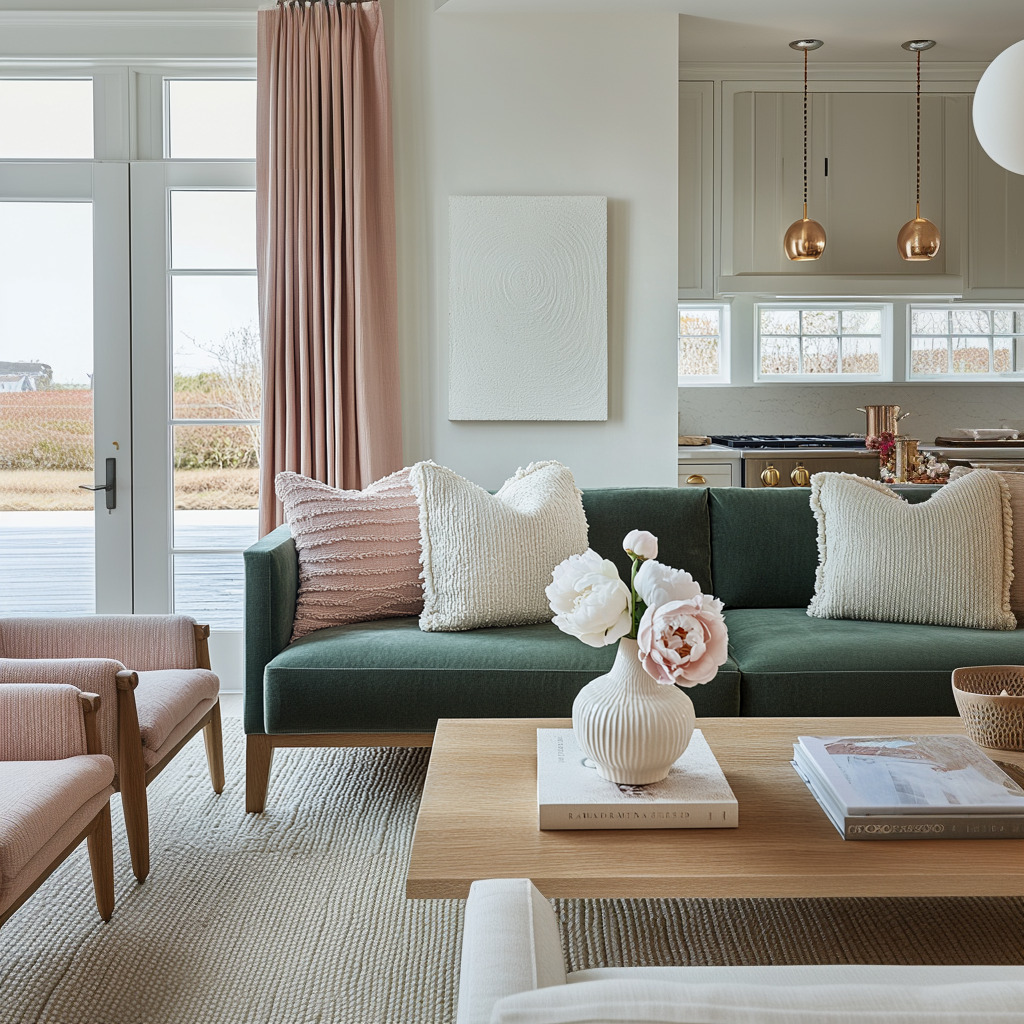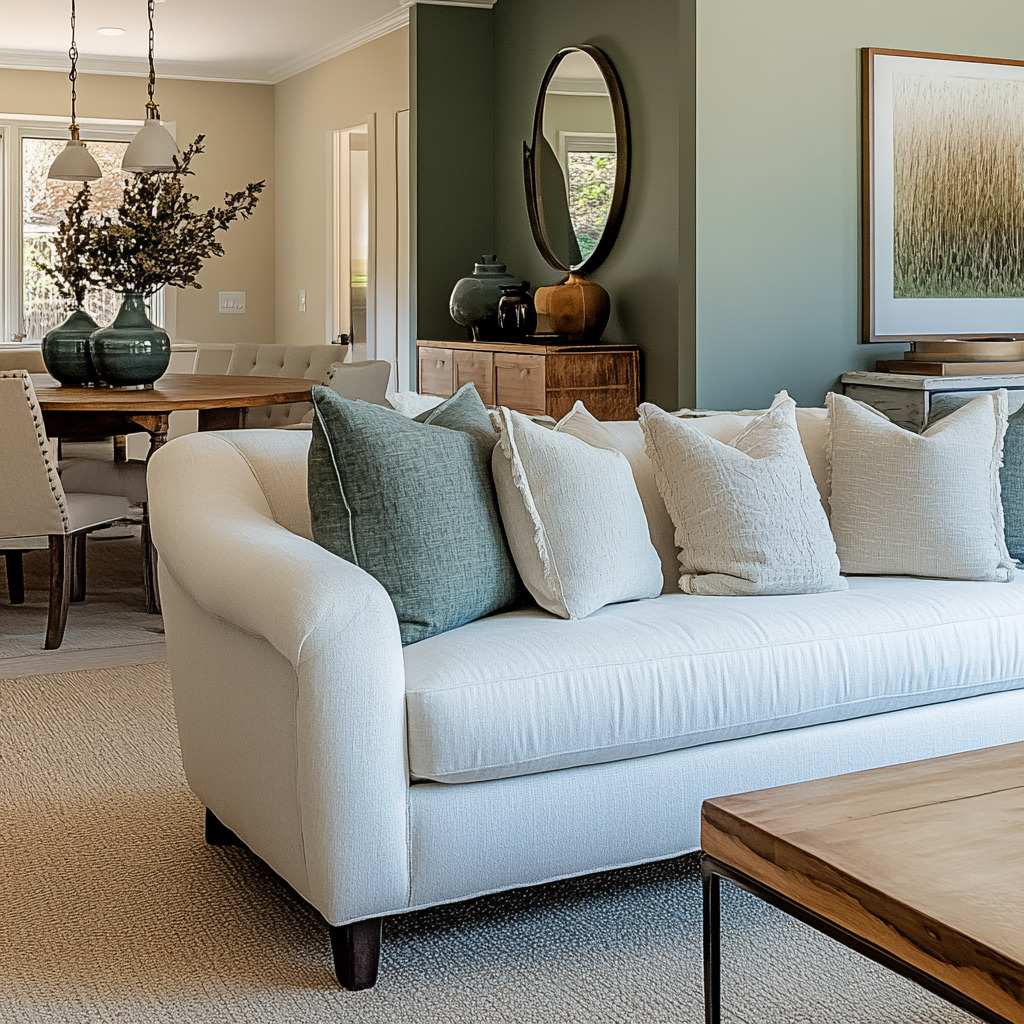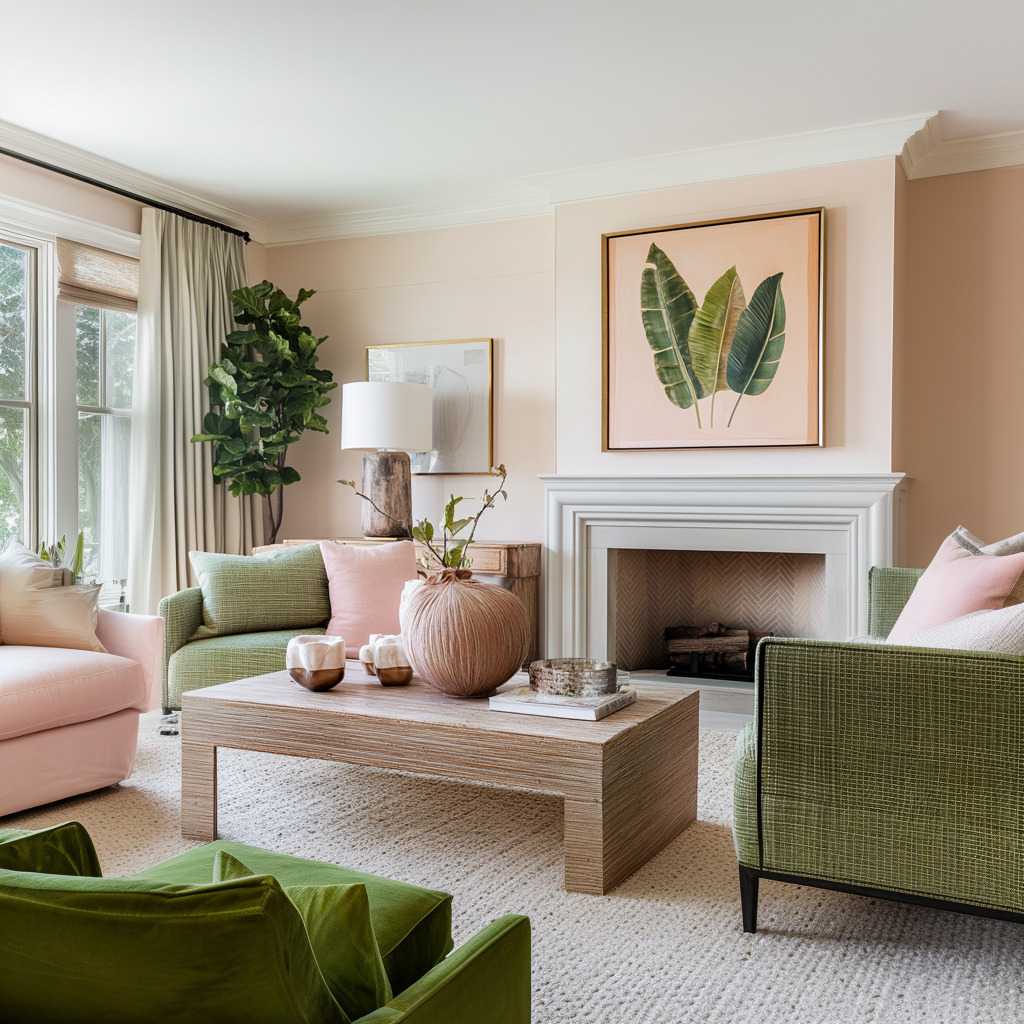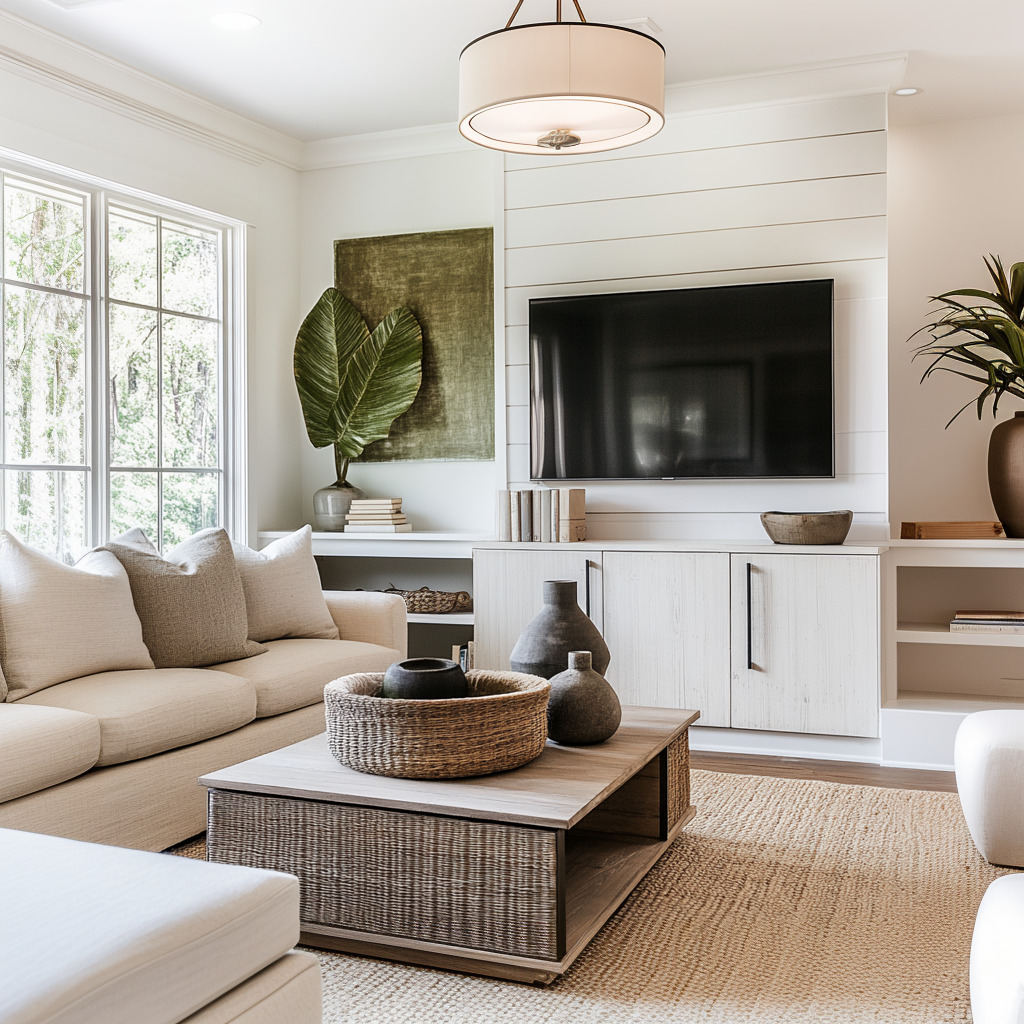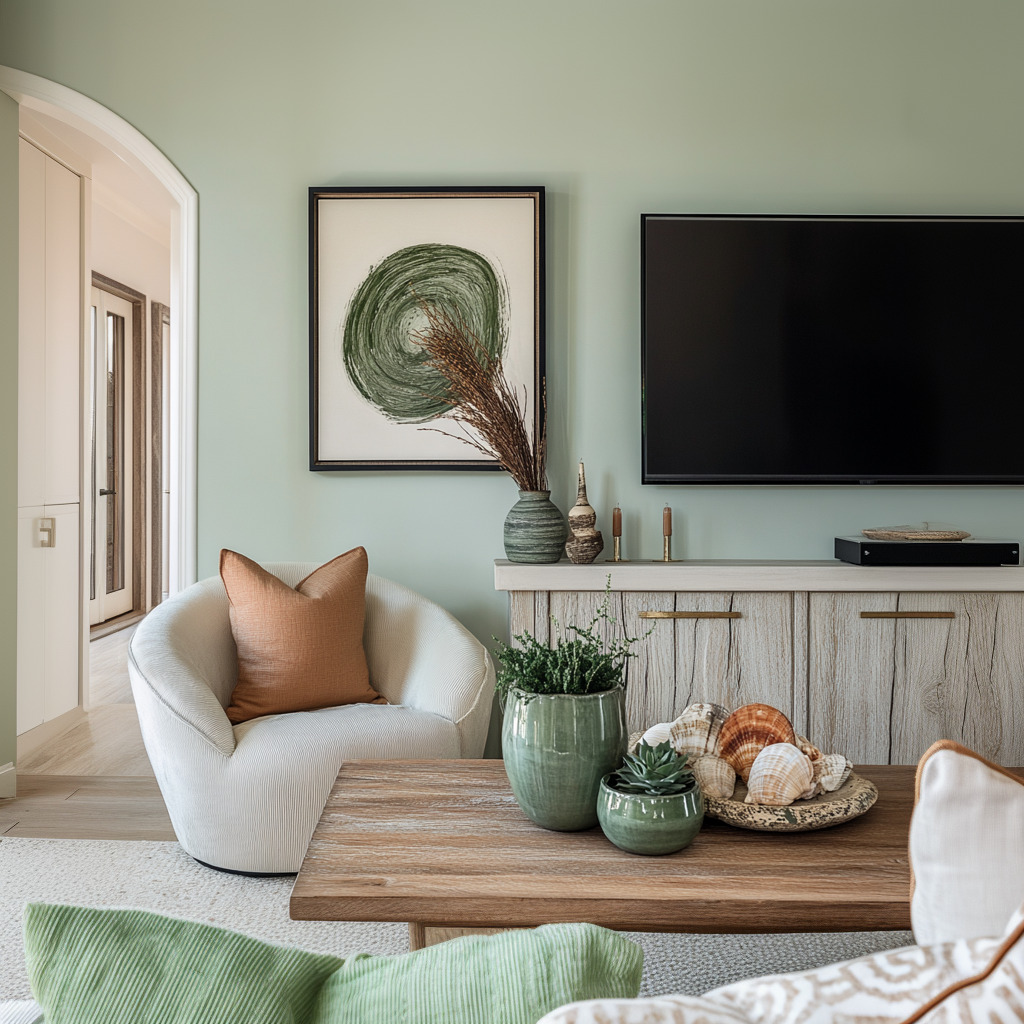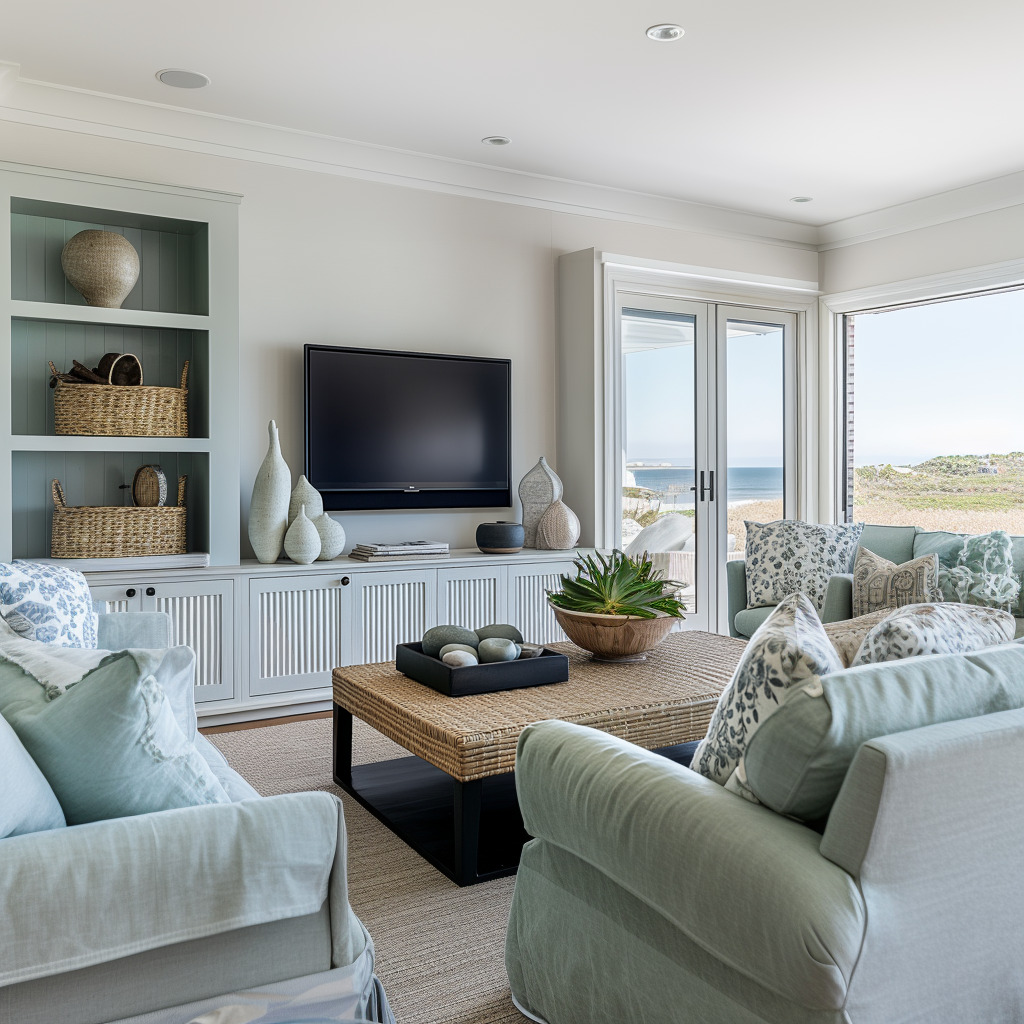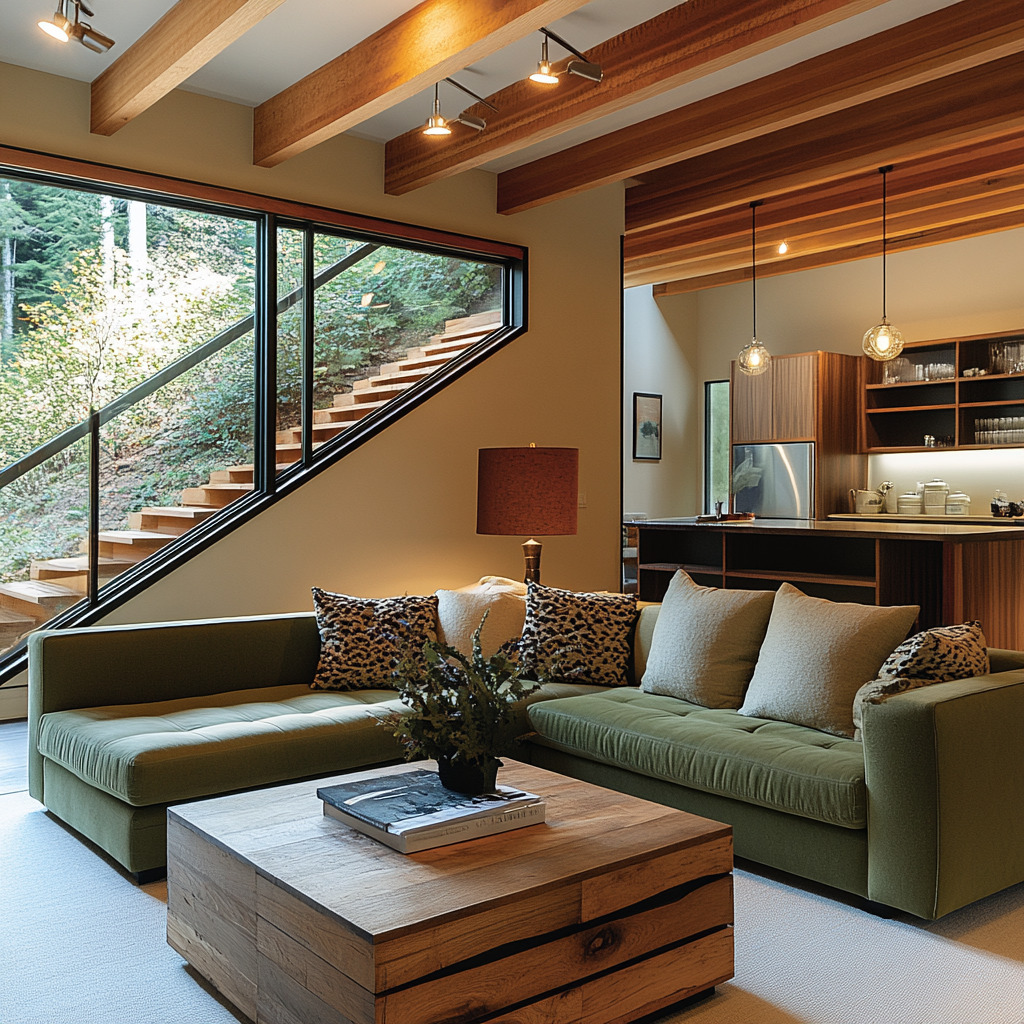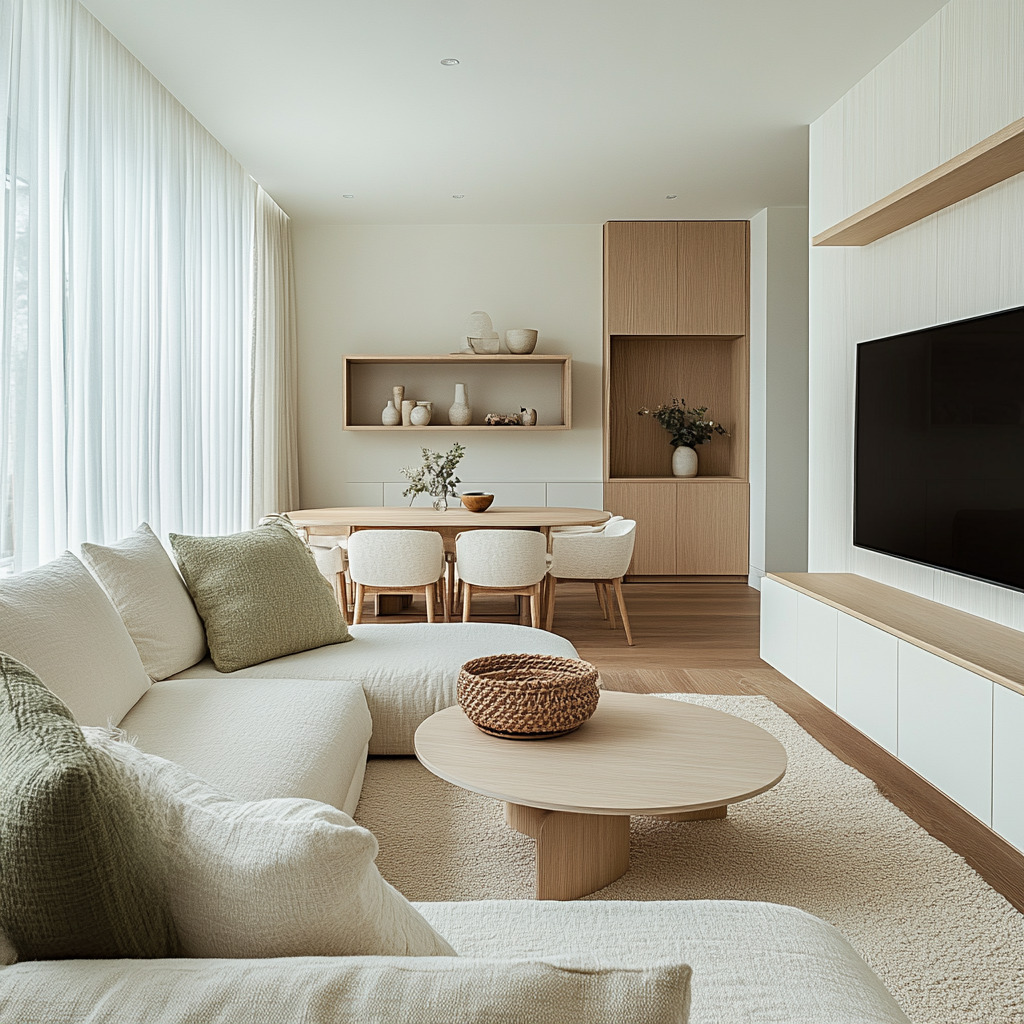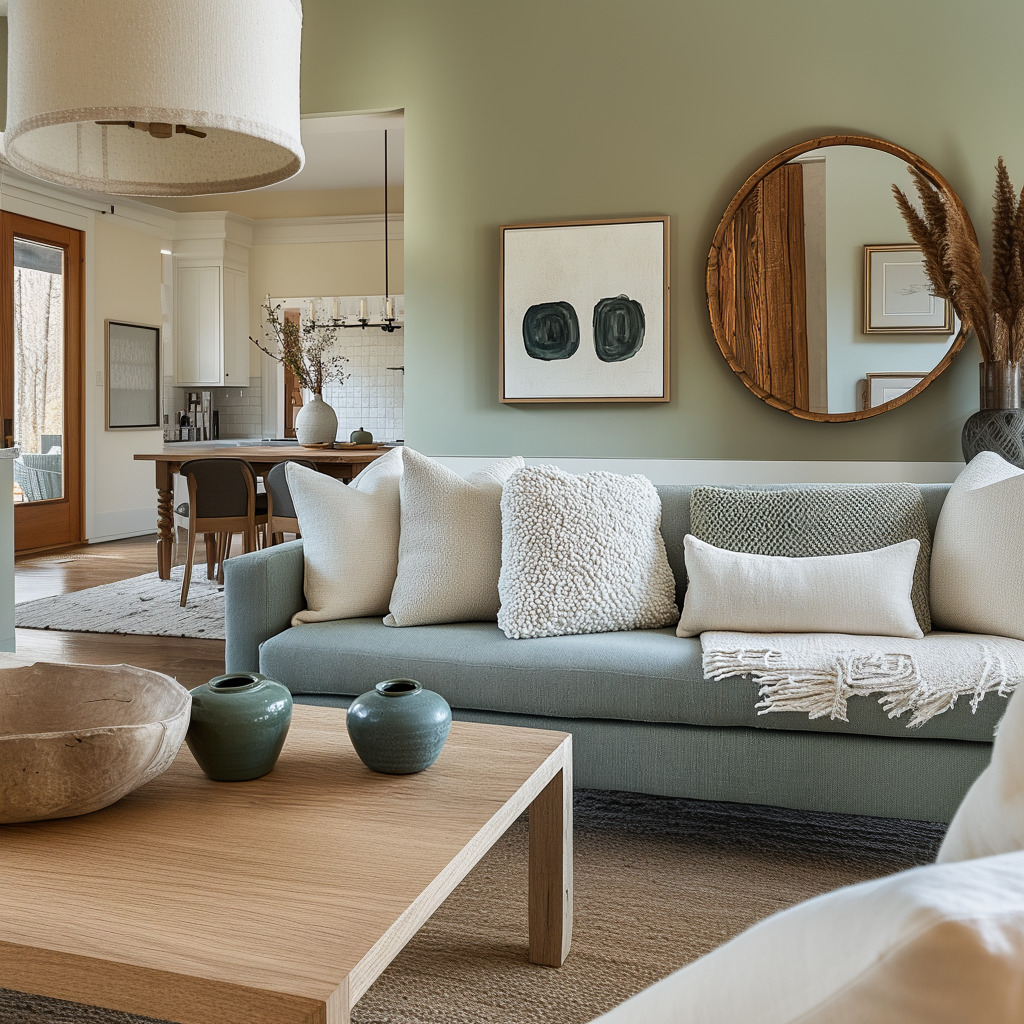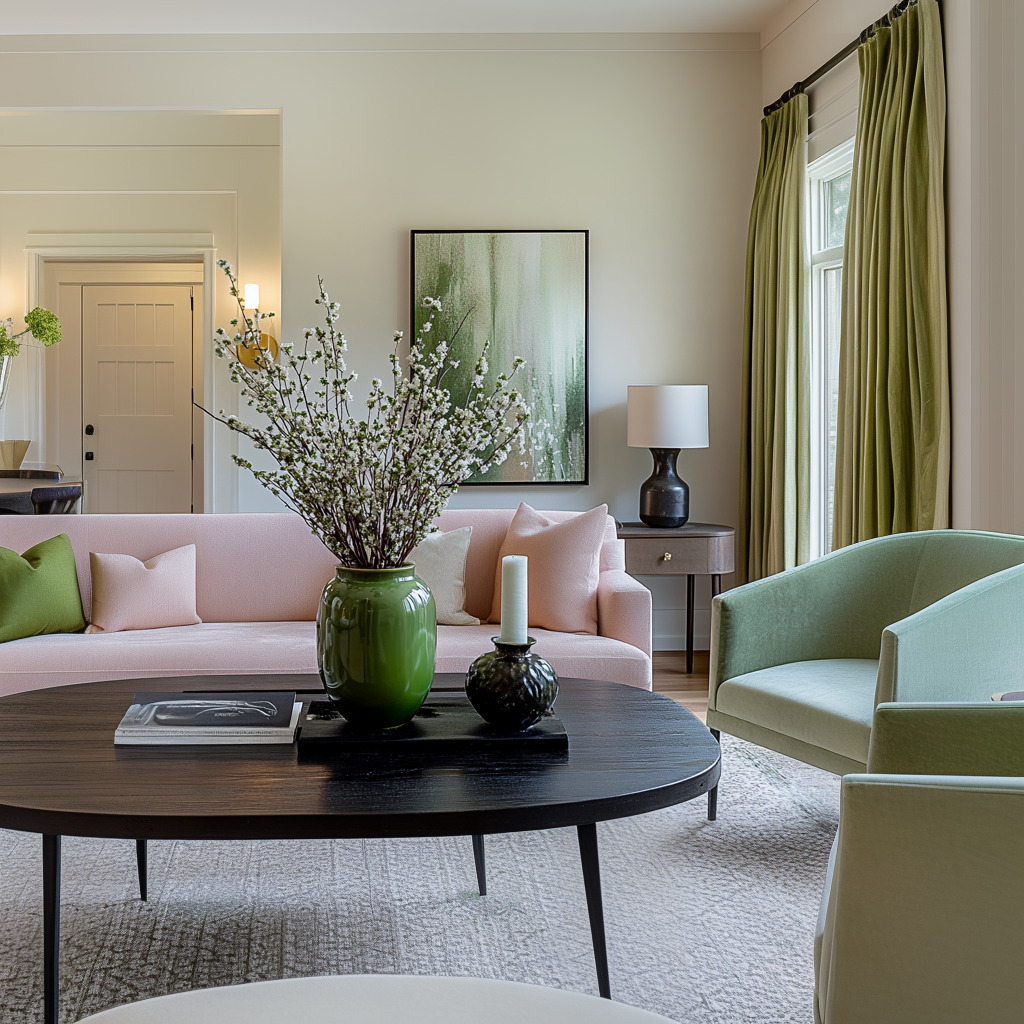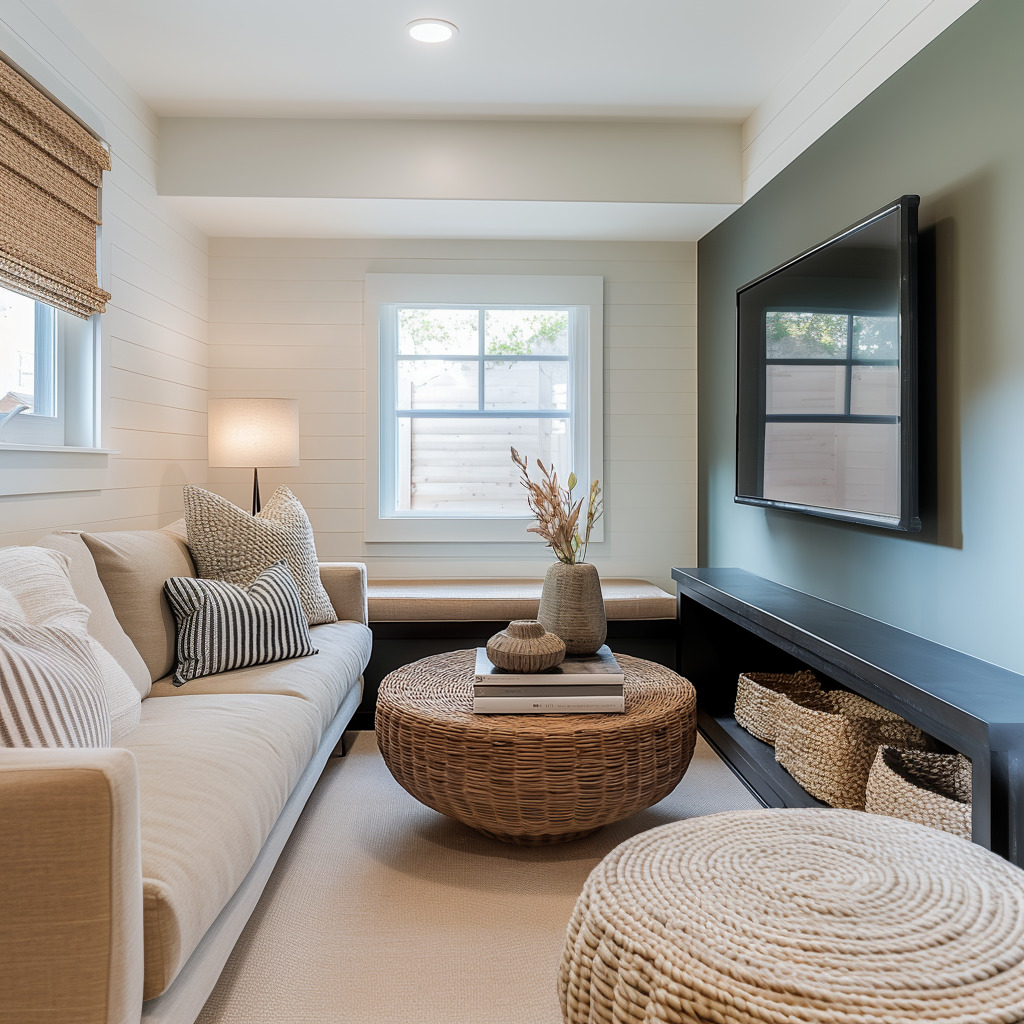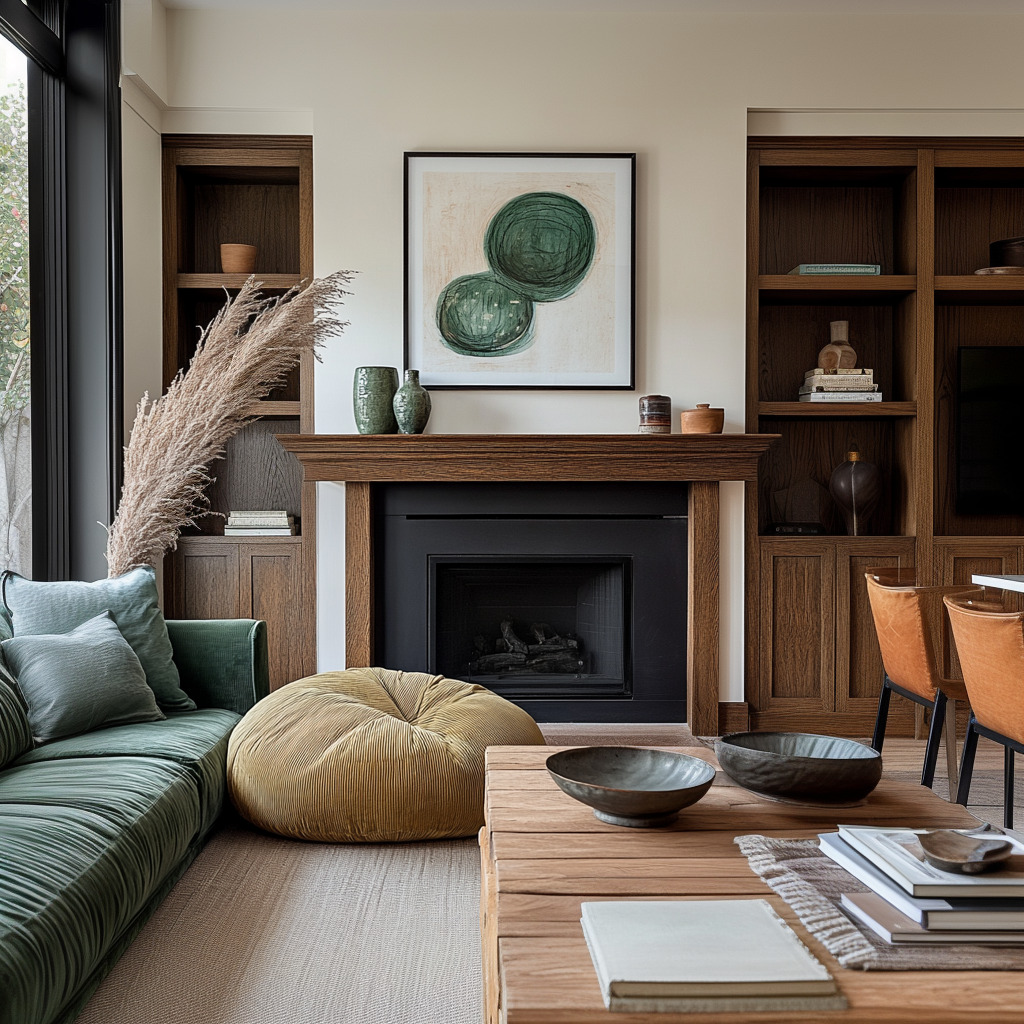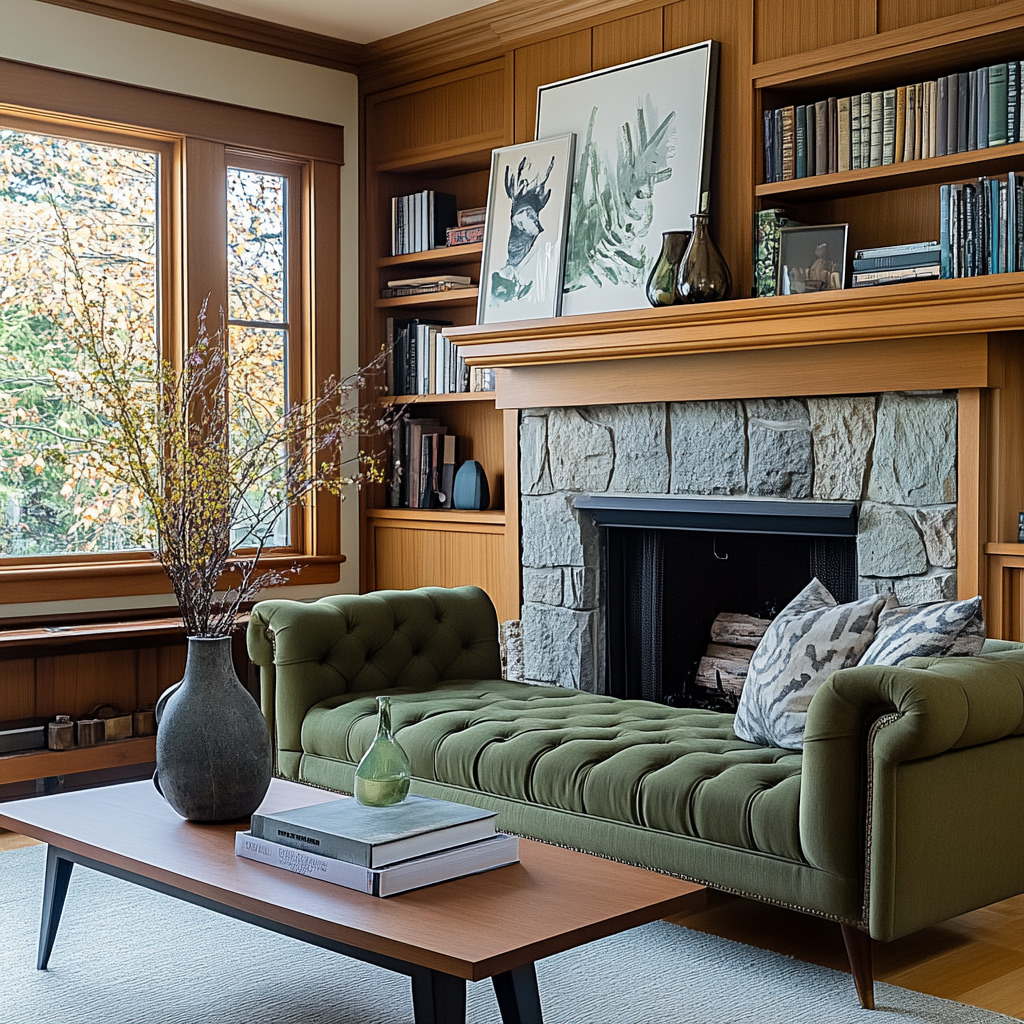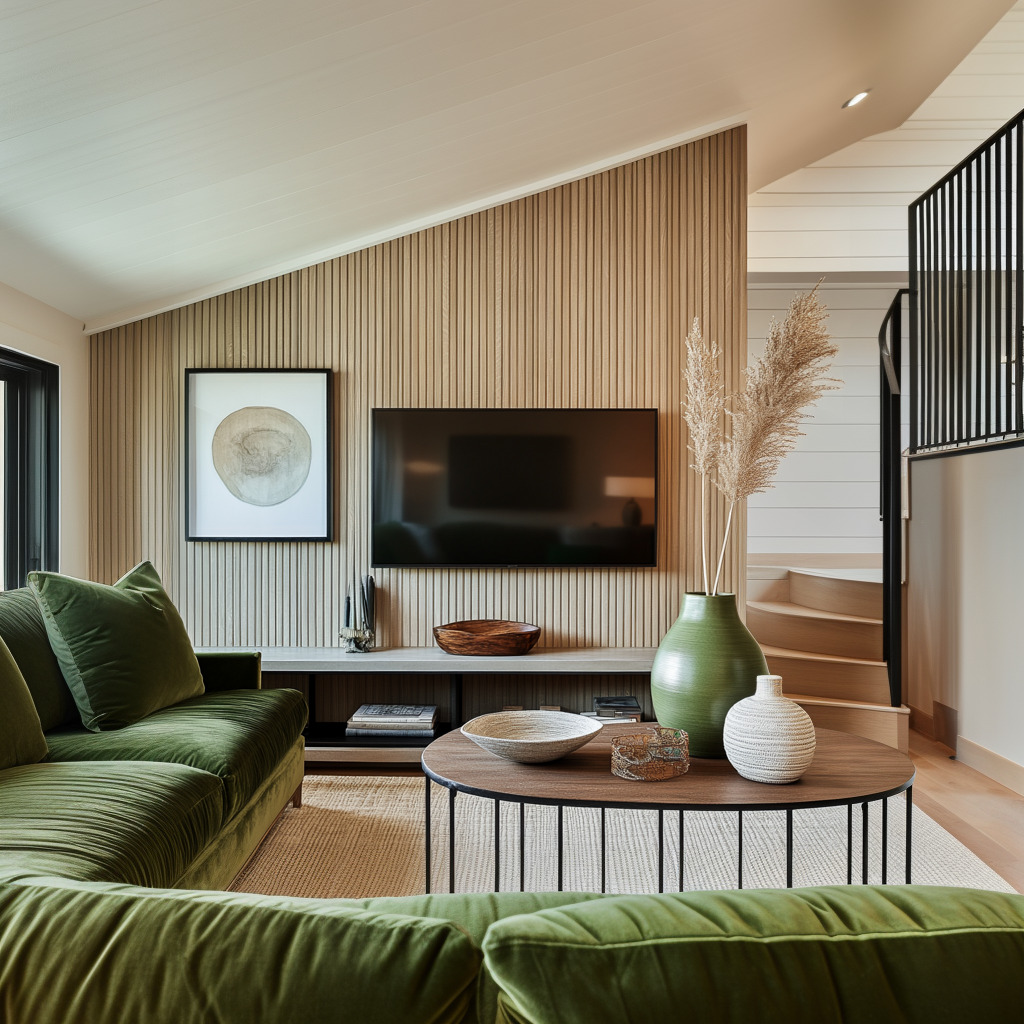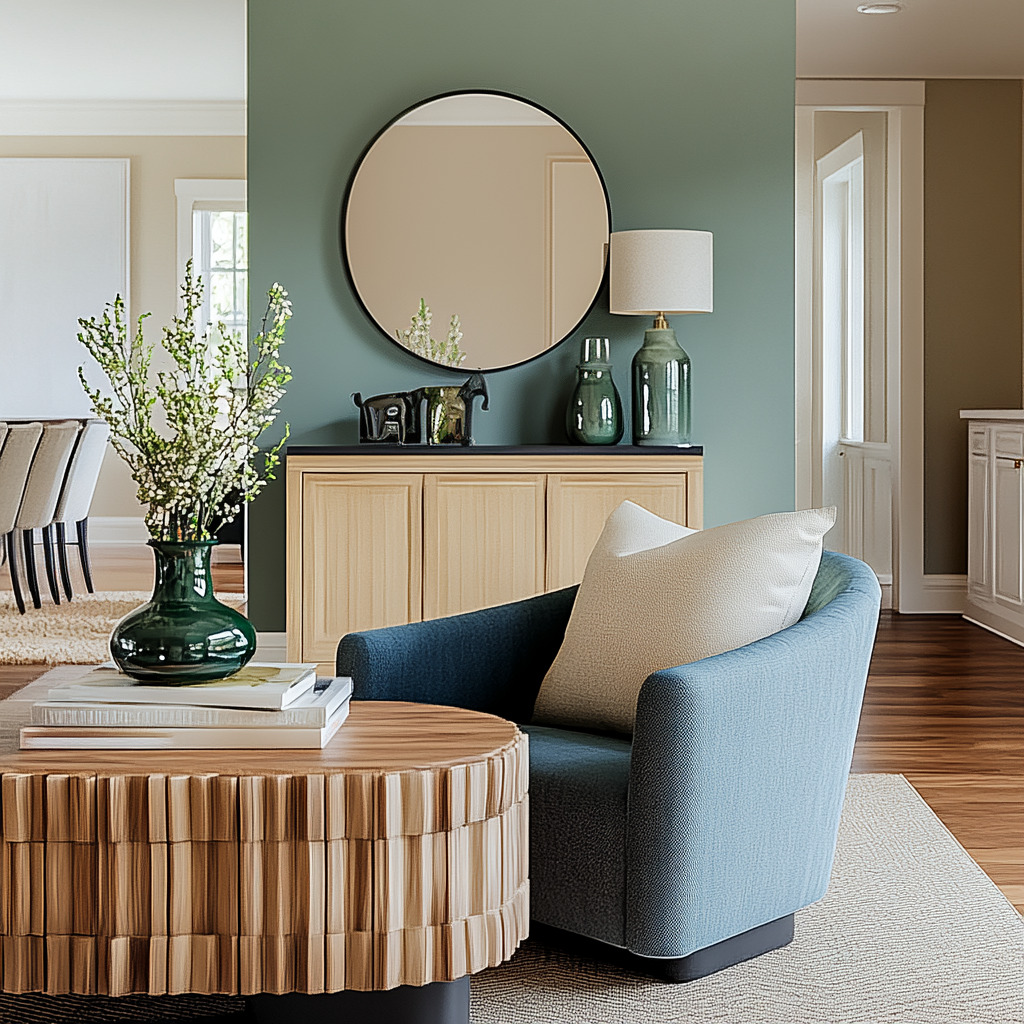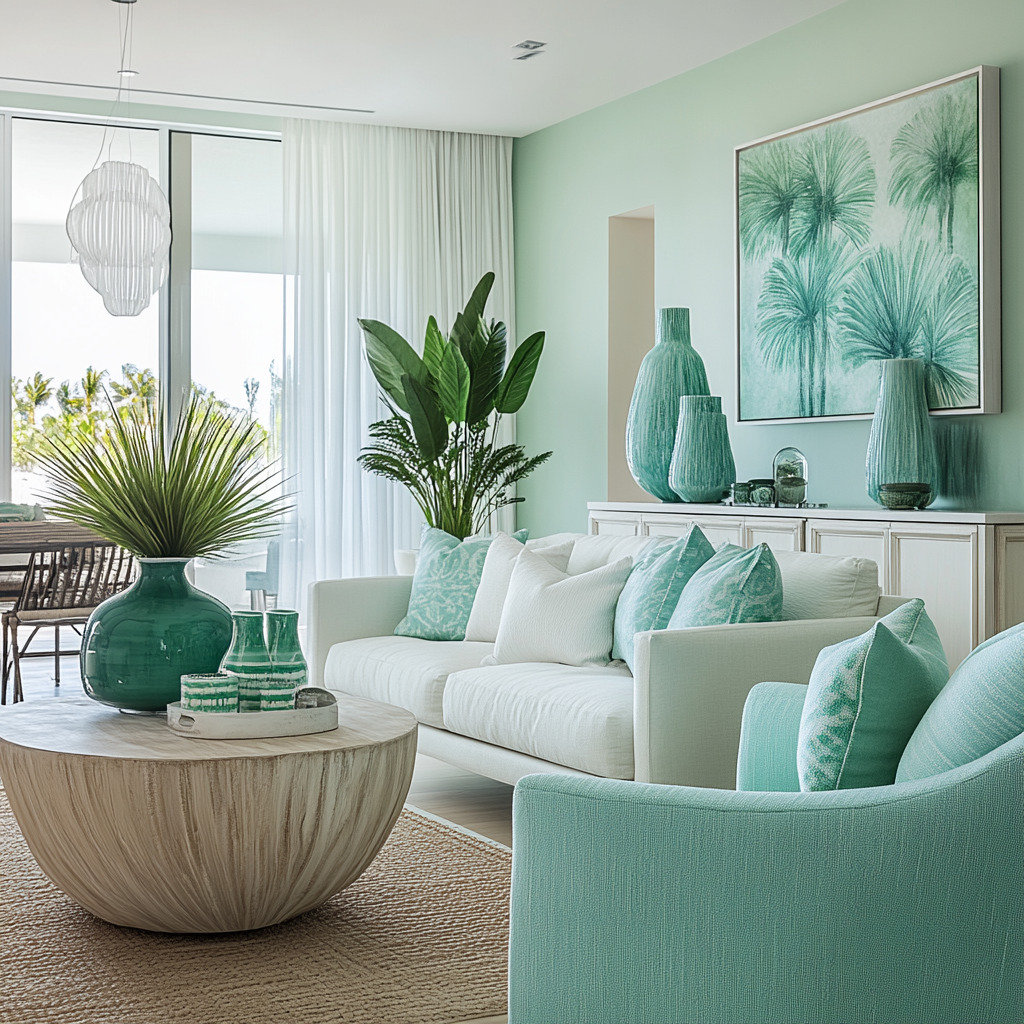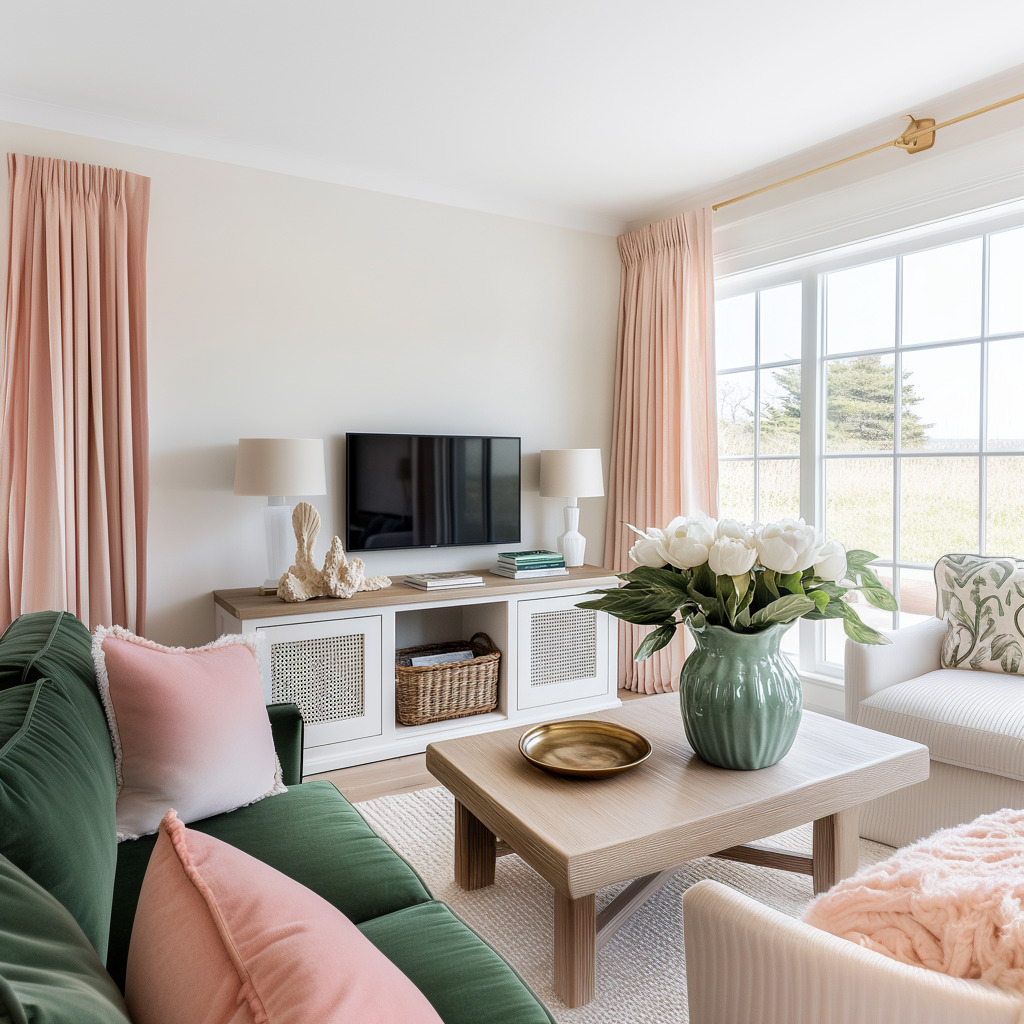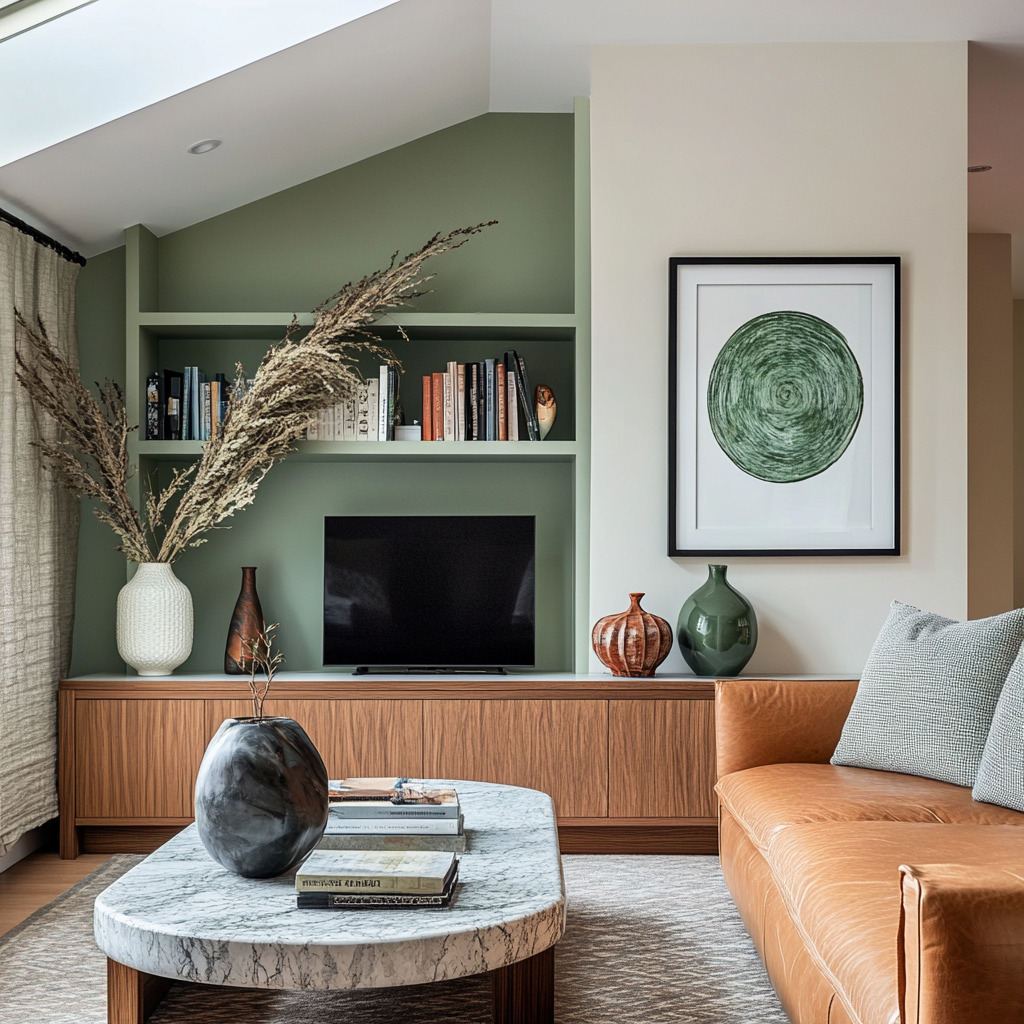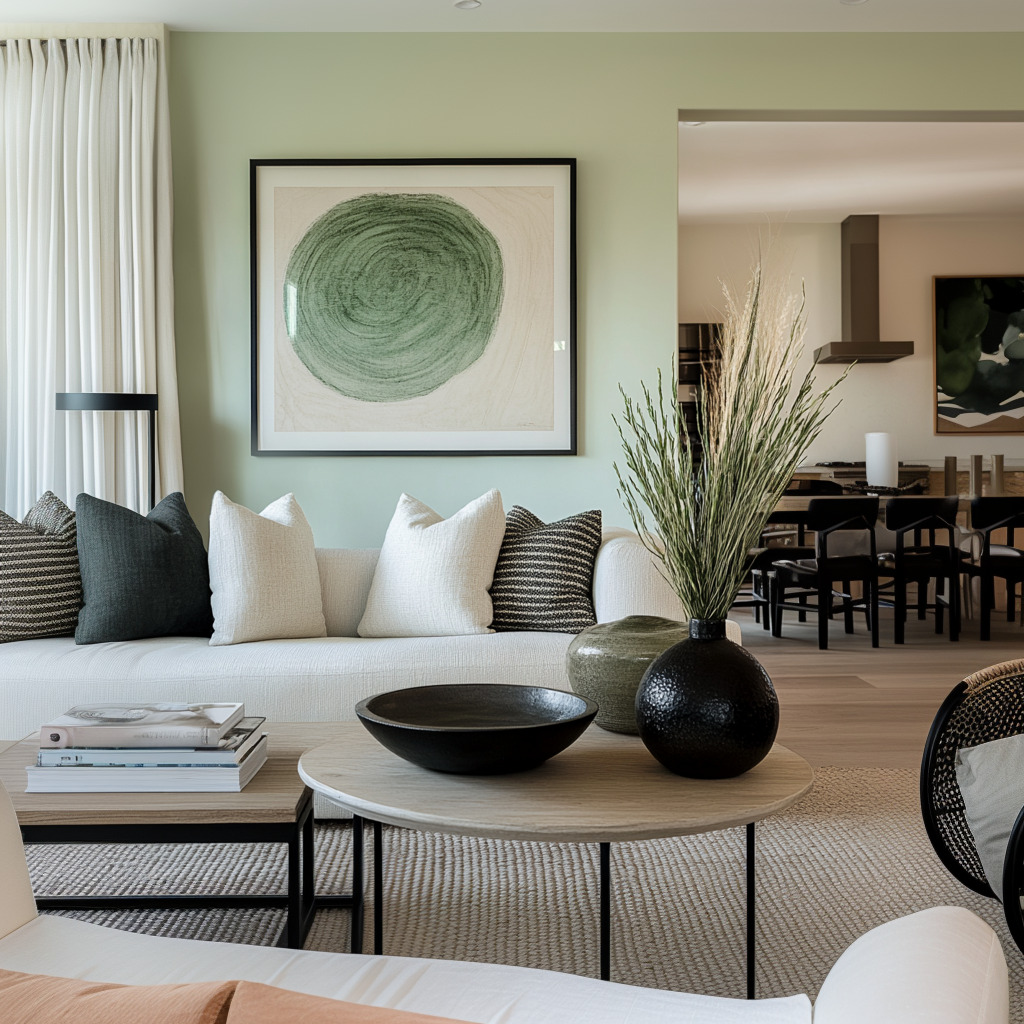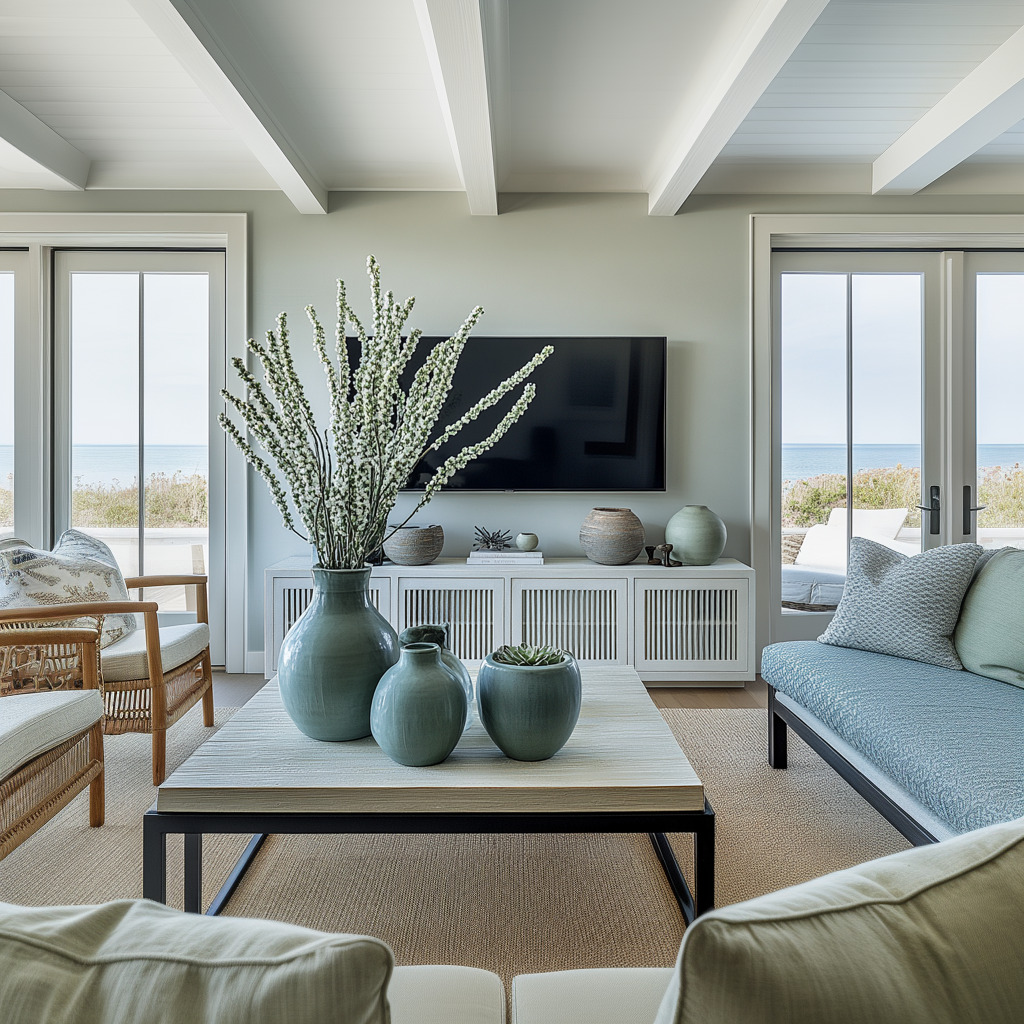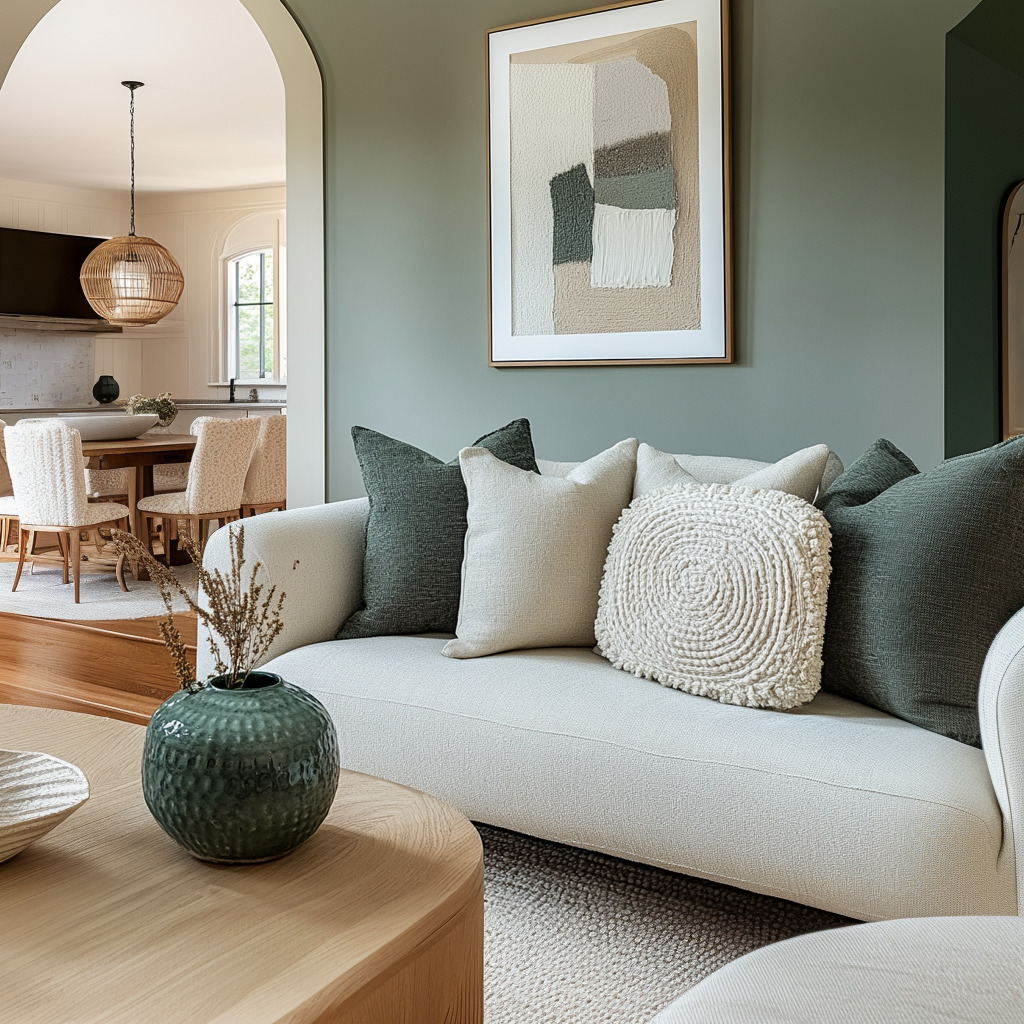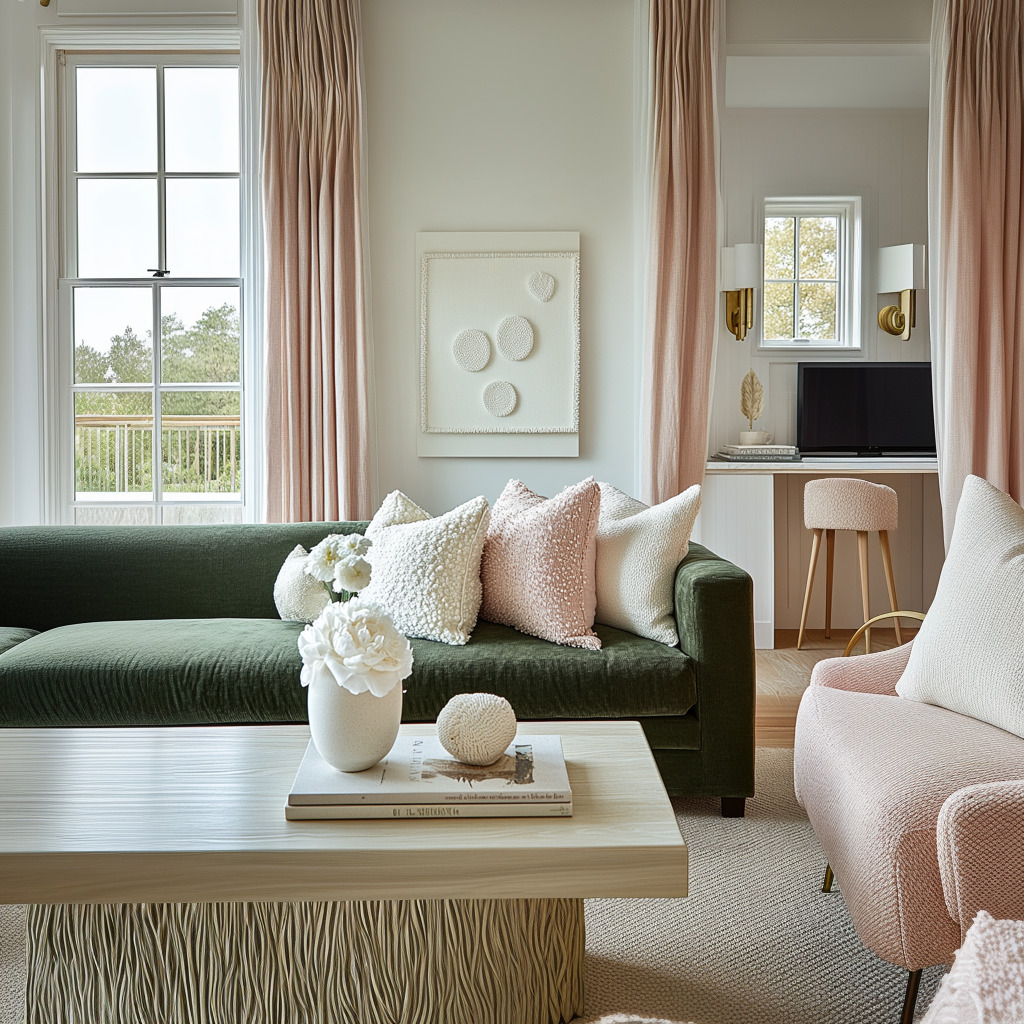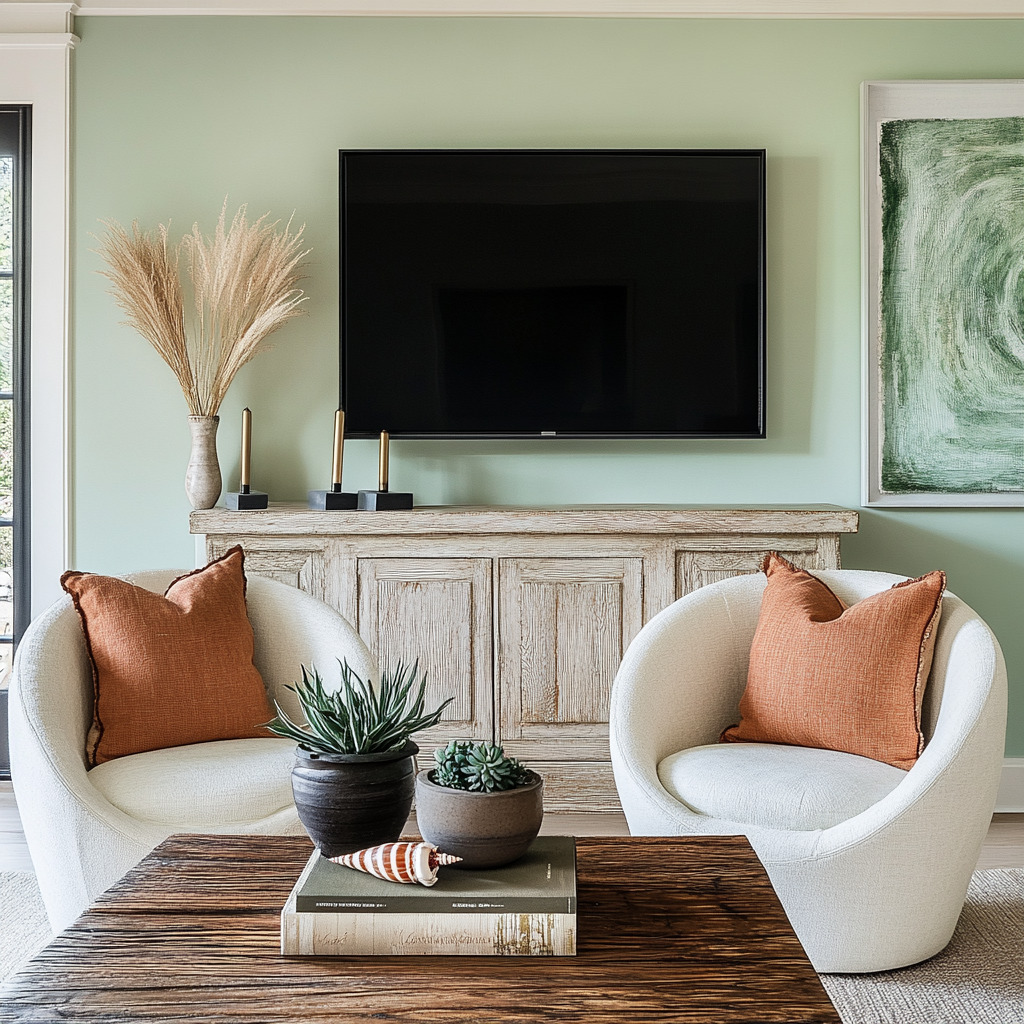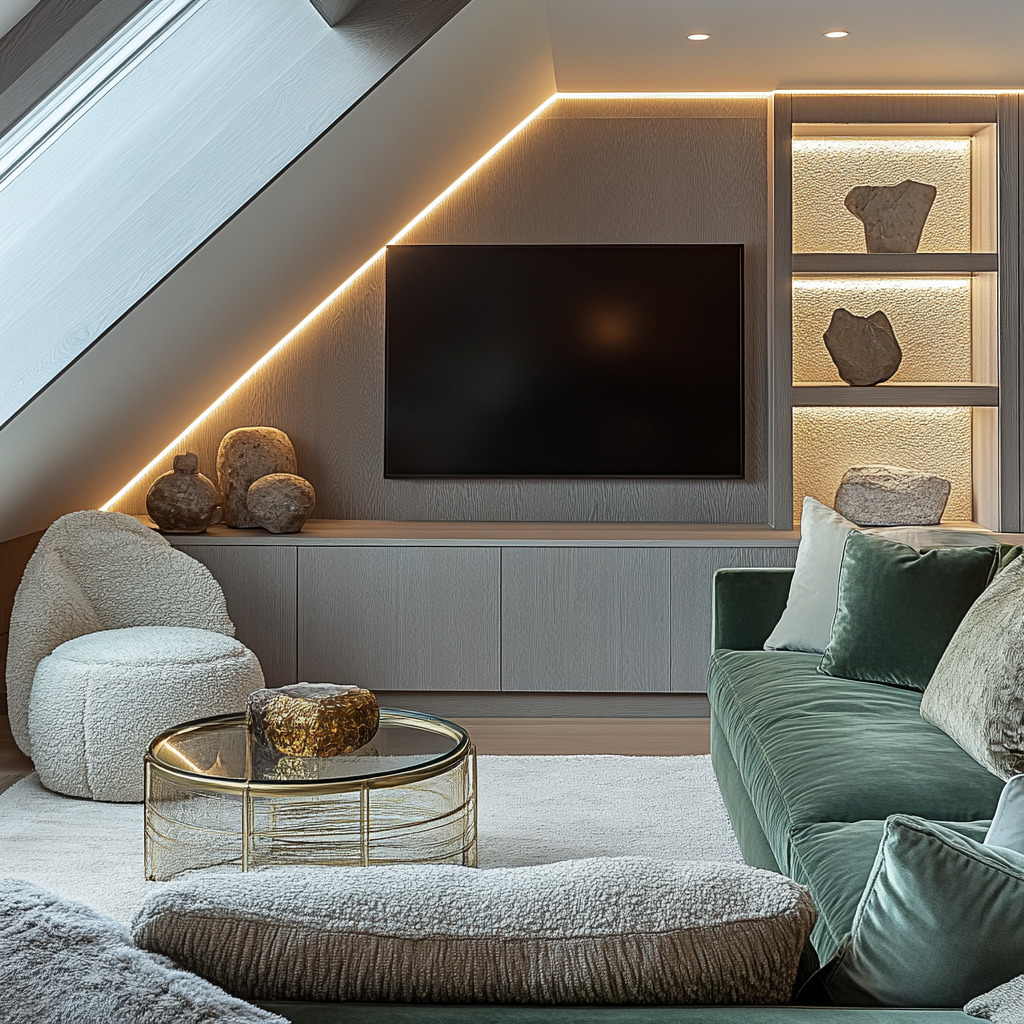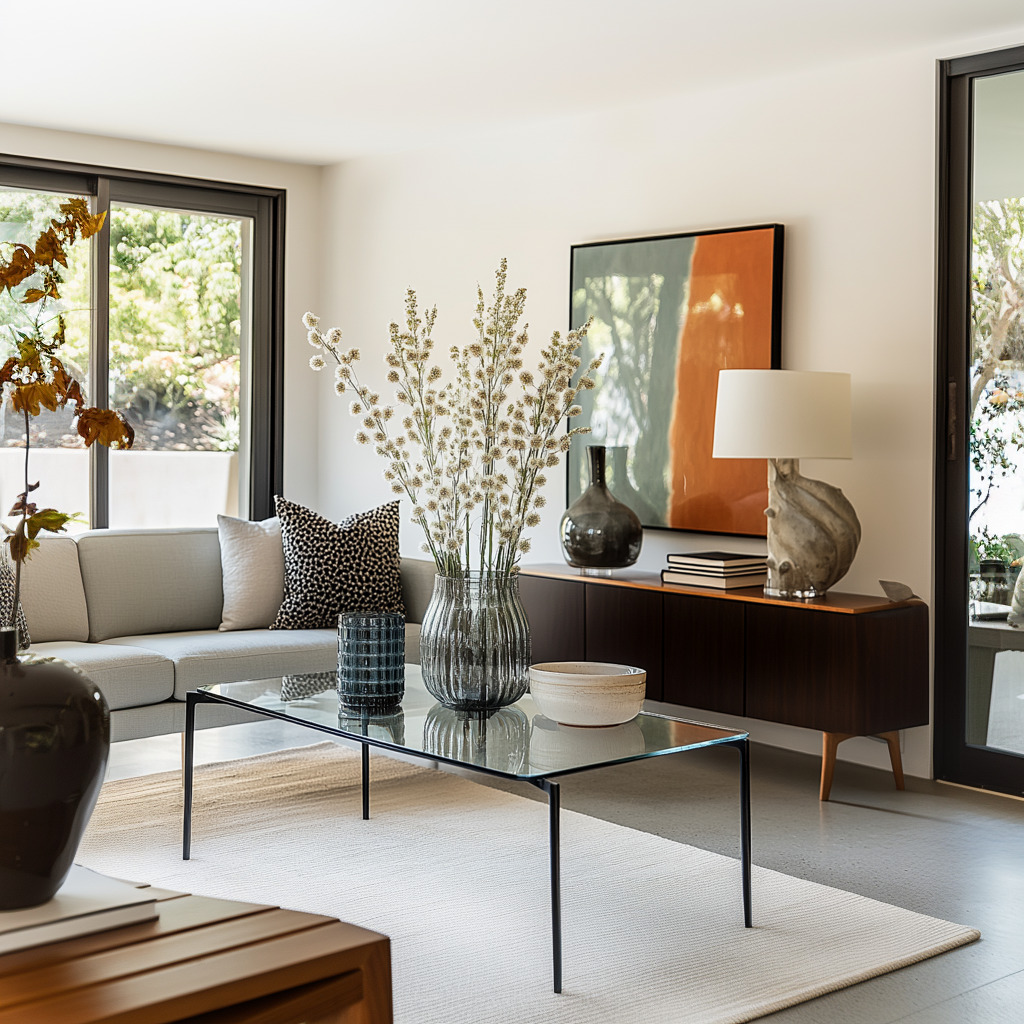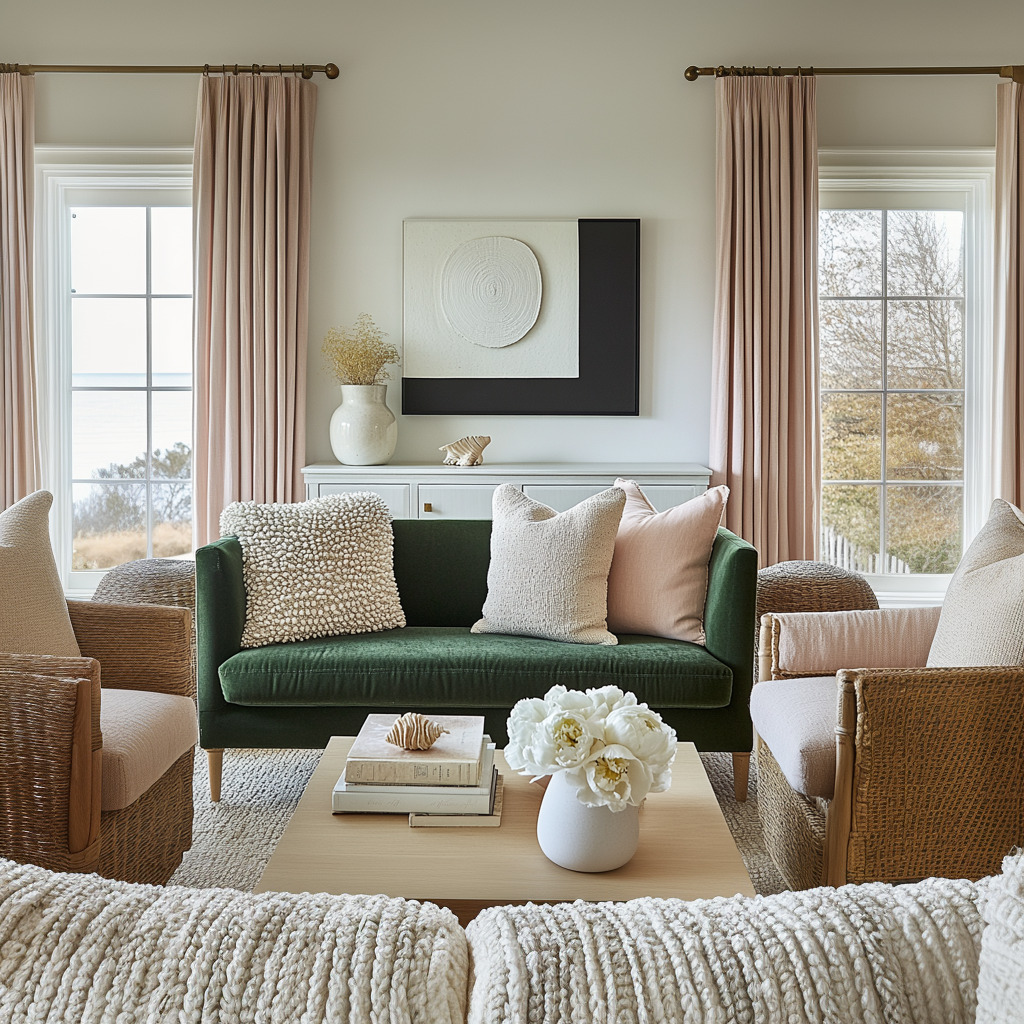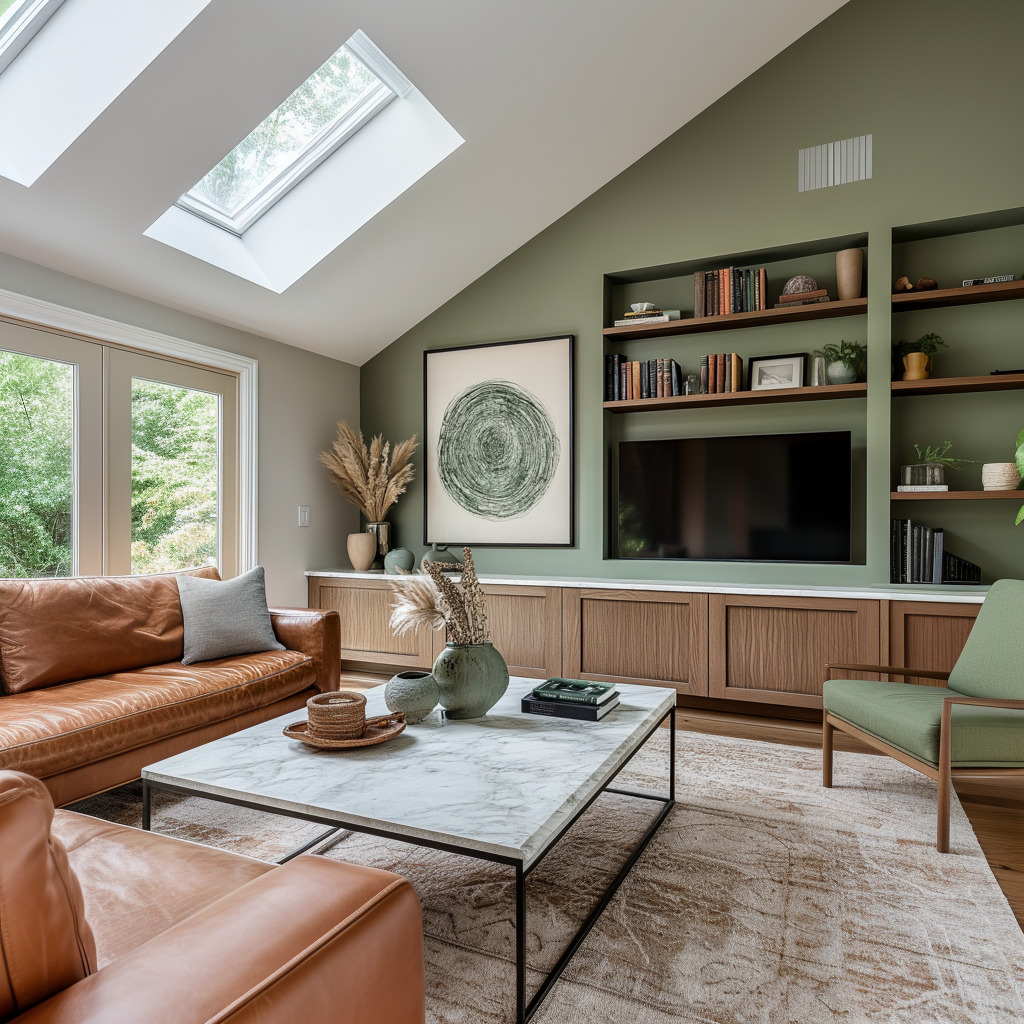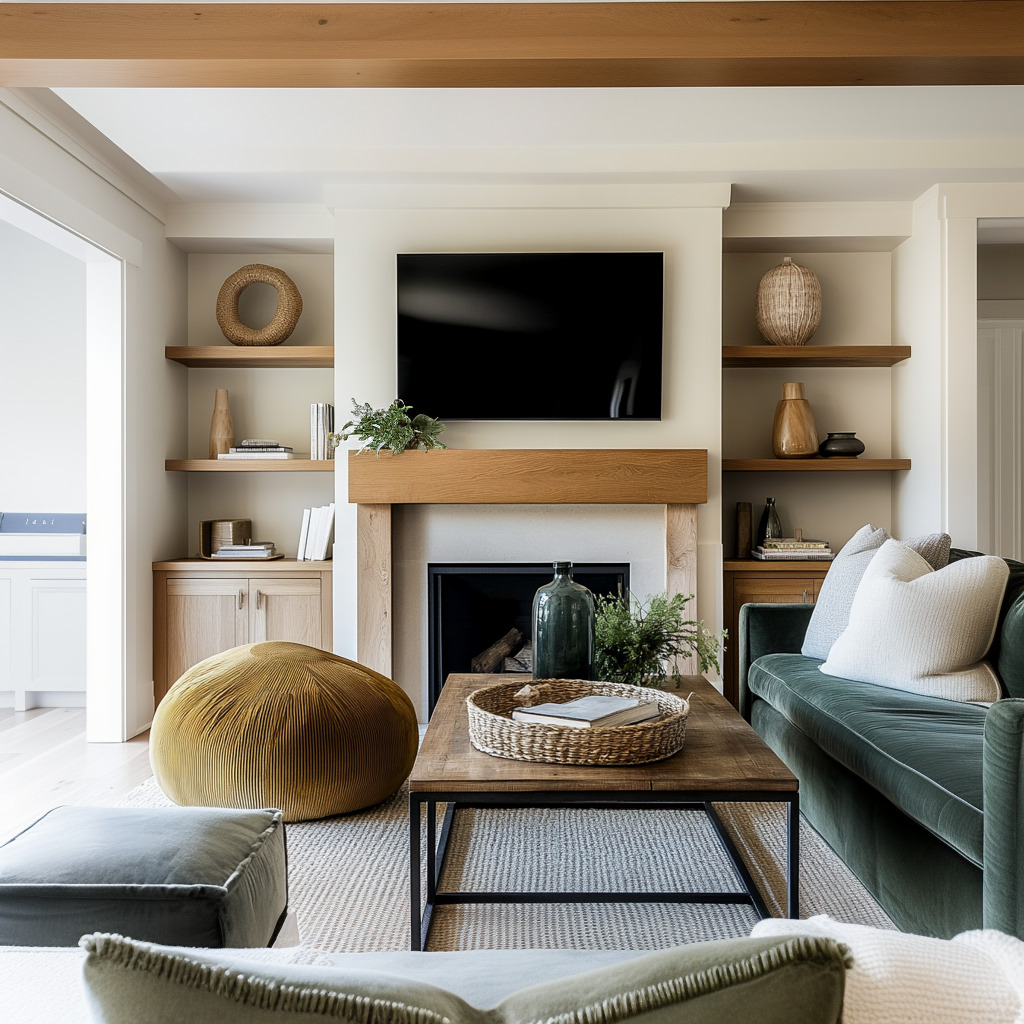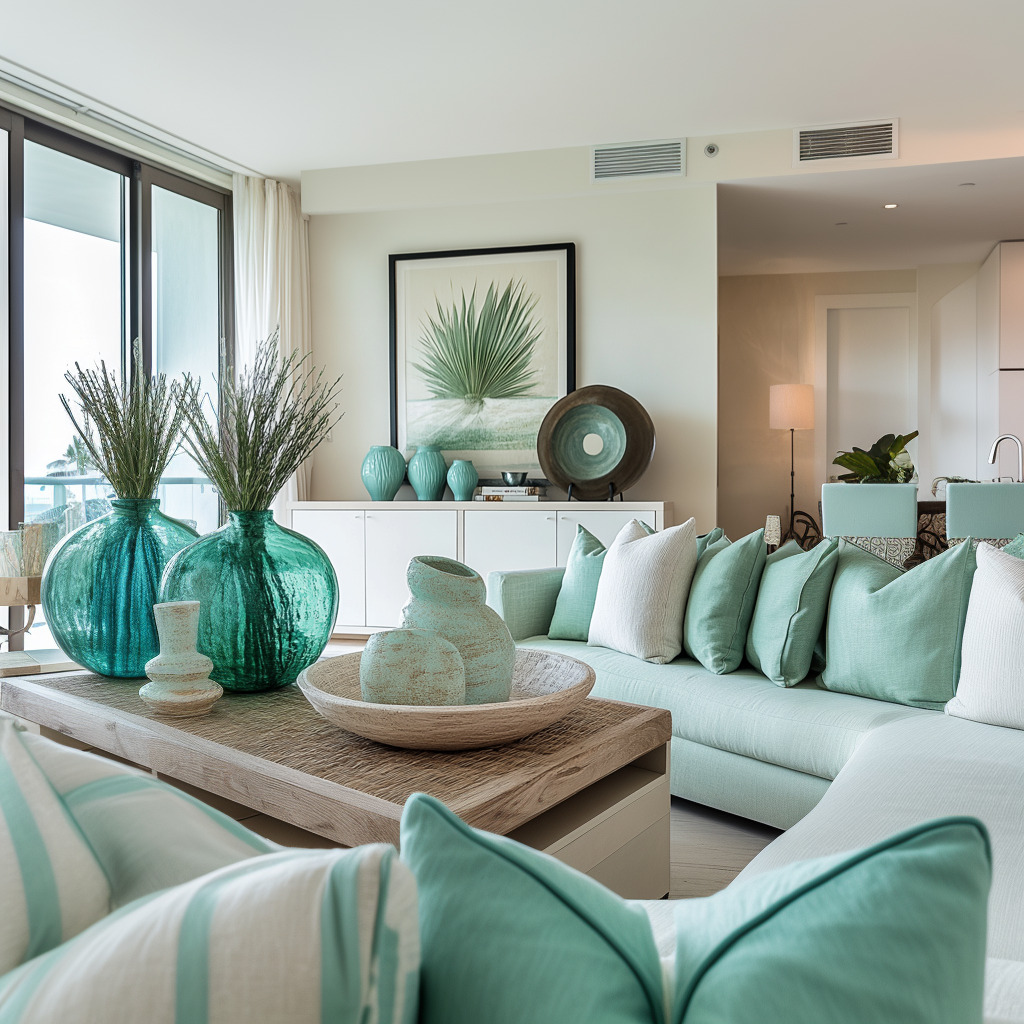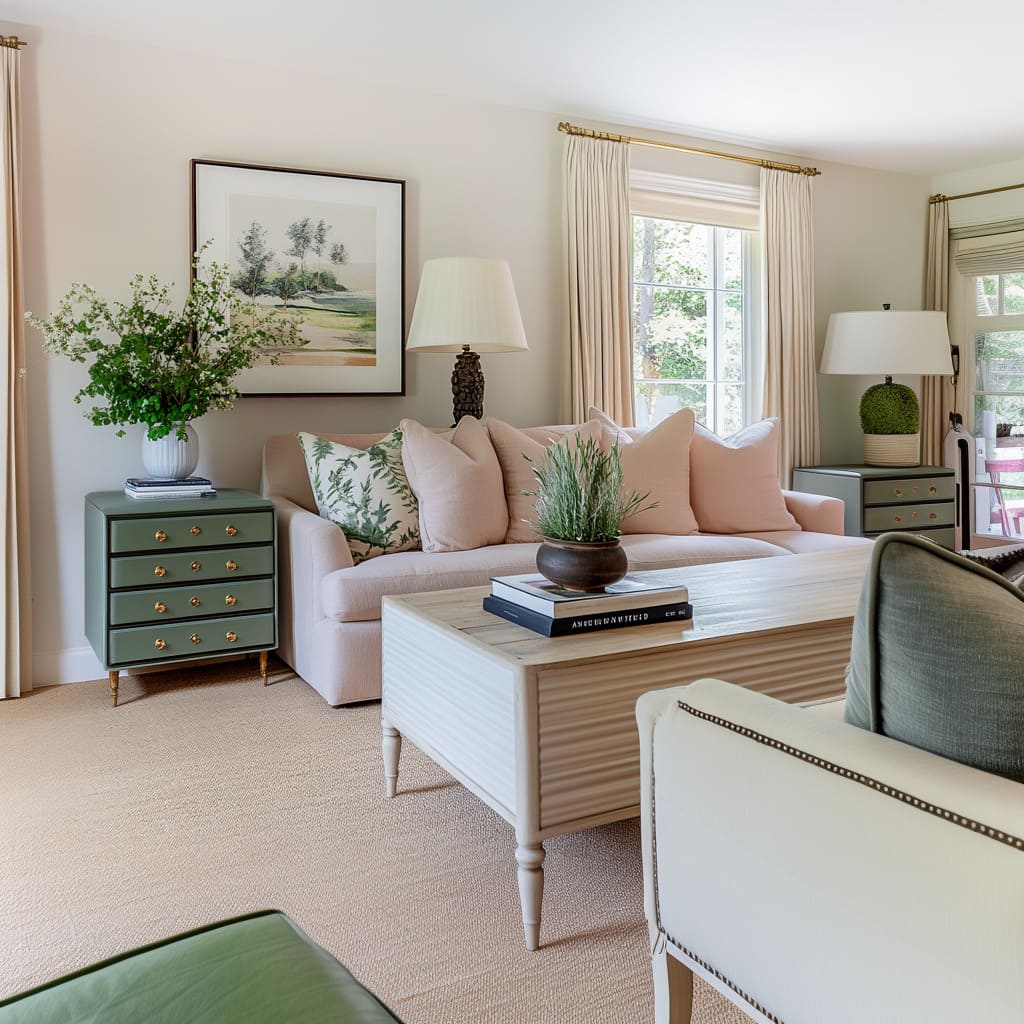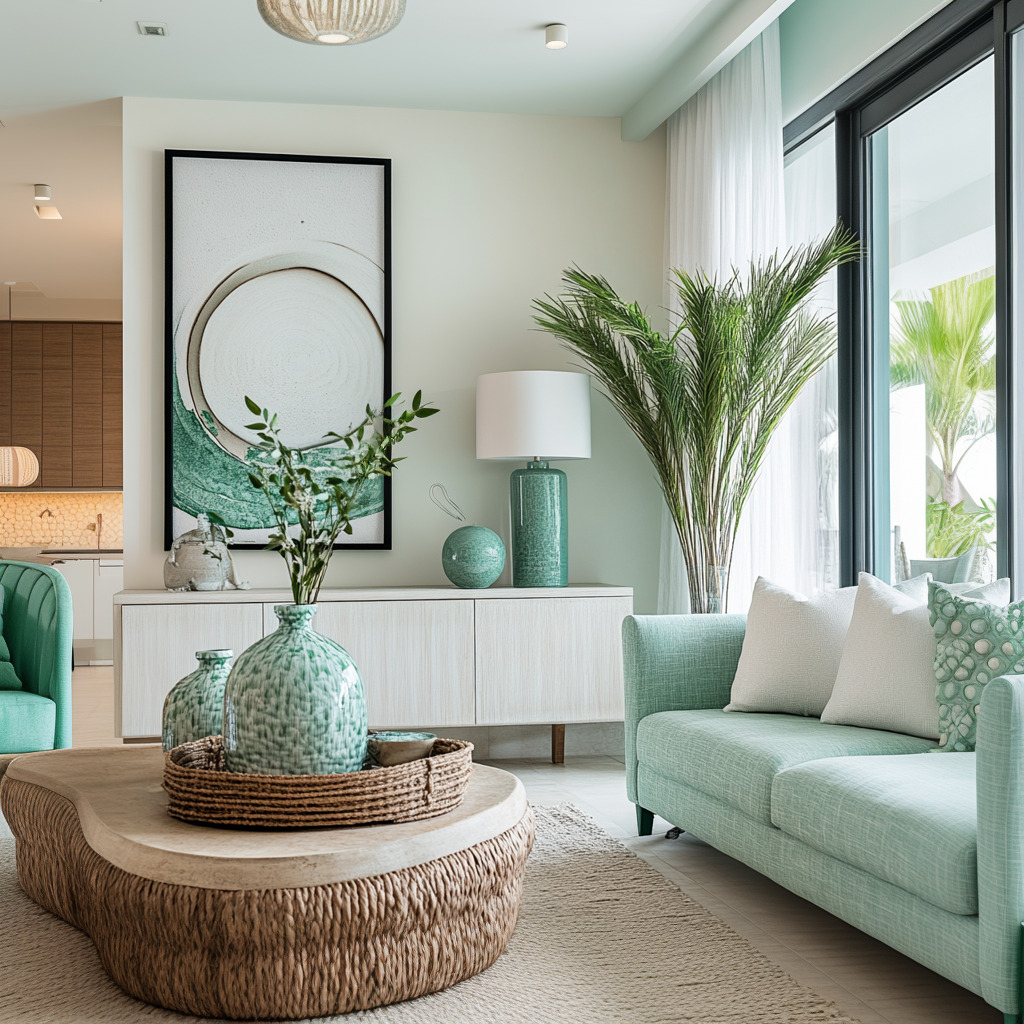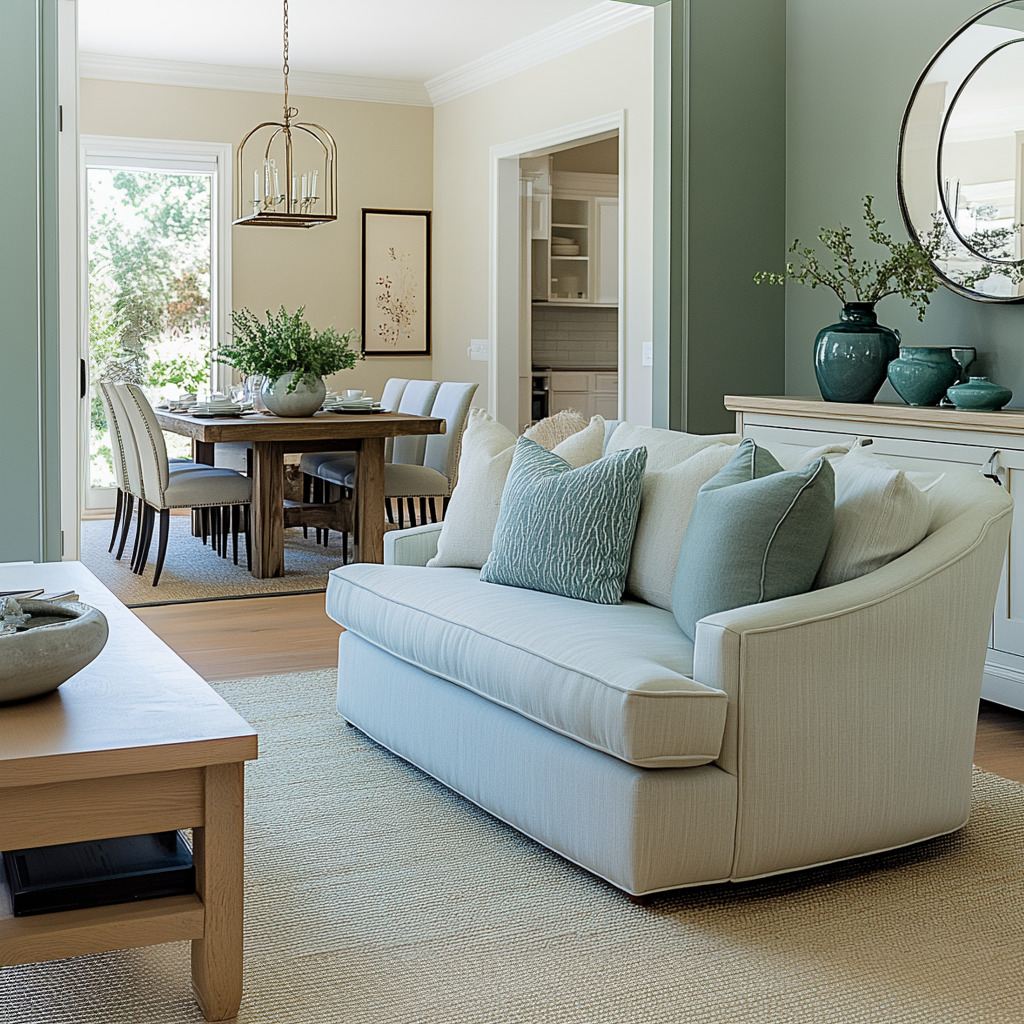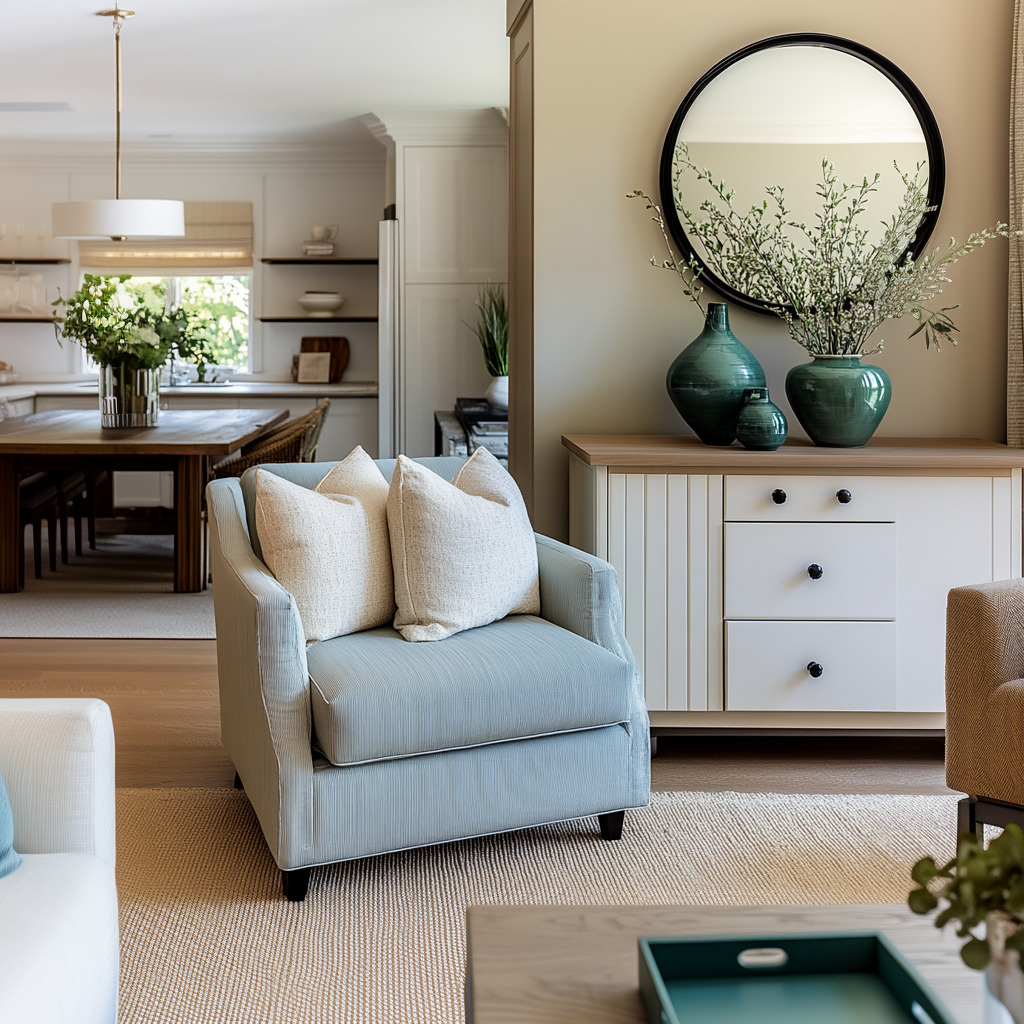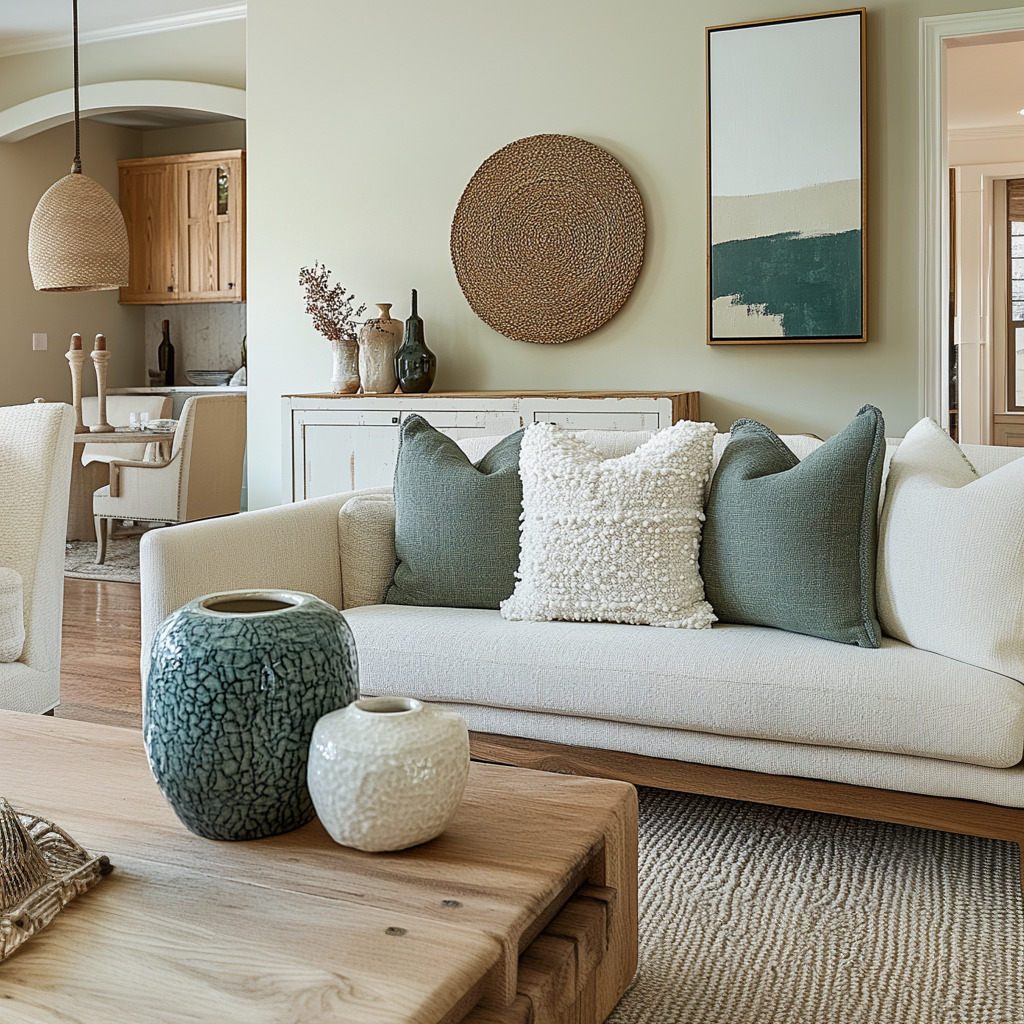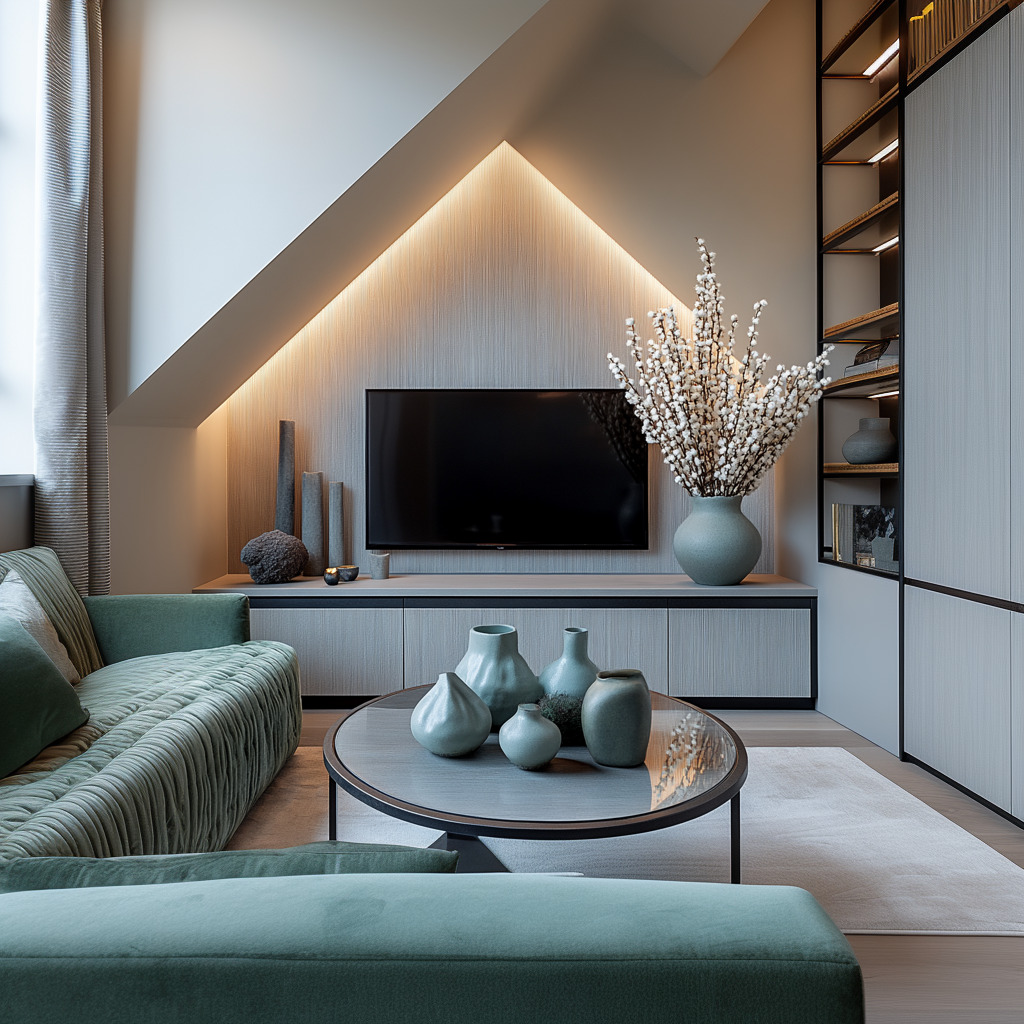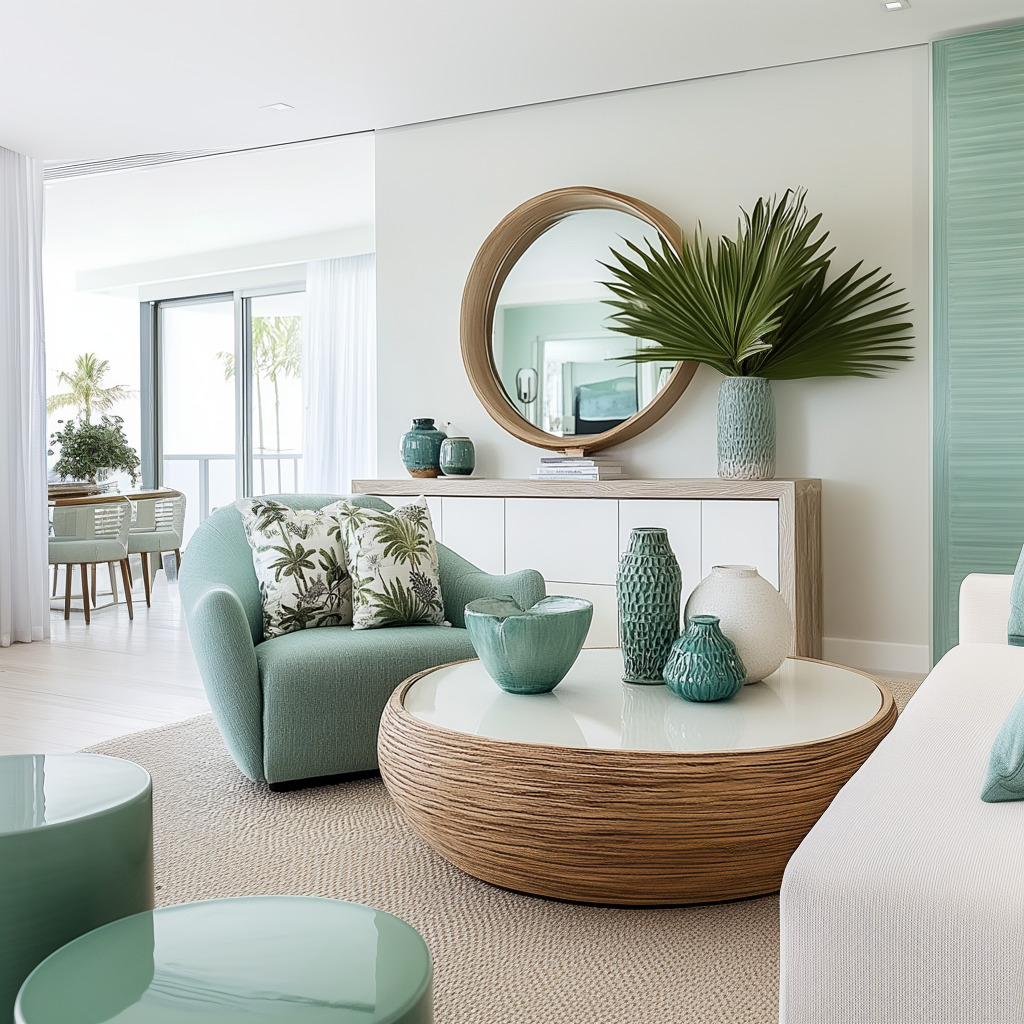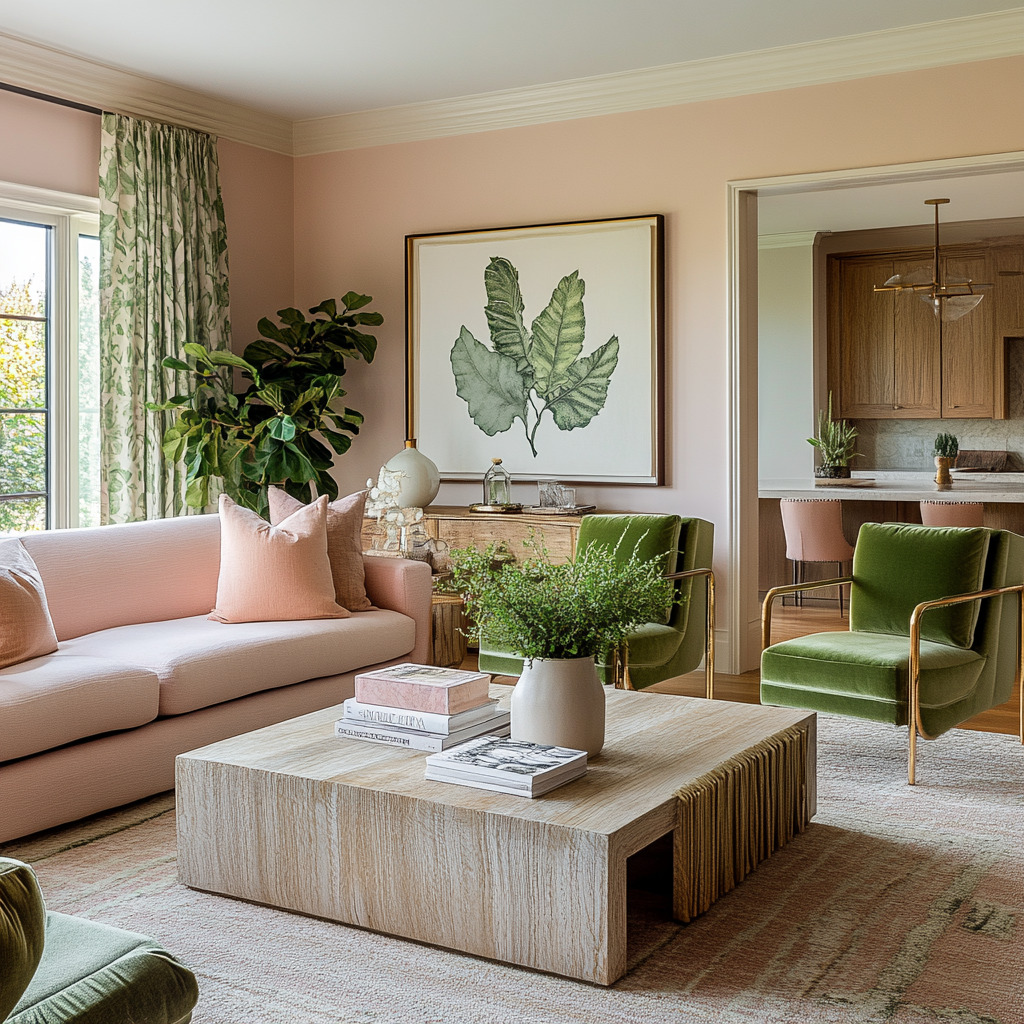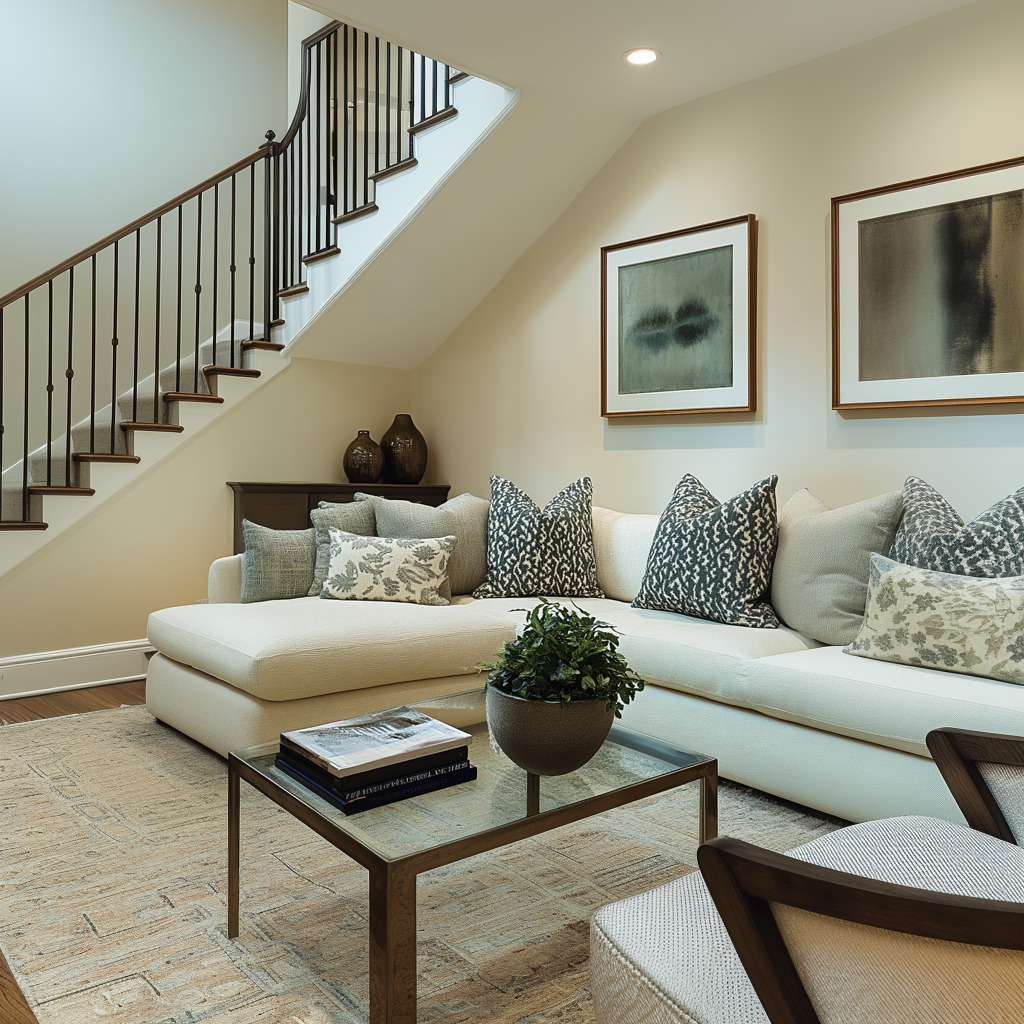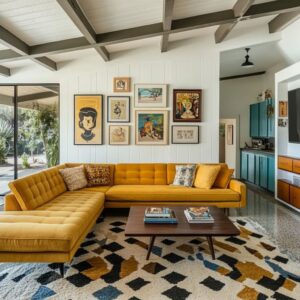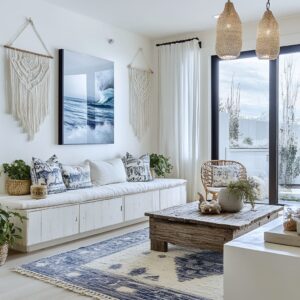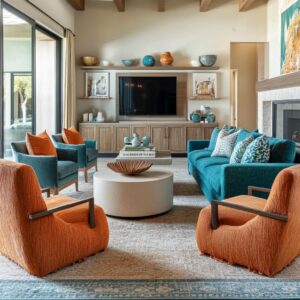Green is a well-loved choice in interior design because it can bring a sense of calm and freshness to any space. In living rooms, this adaptable color can appear in different ways—vibrant furniture, gentle wall hues, or smaller decor details—making it easy to fit into a variety of personal styles.
From profound emerald to soothing sage, green can work seamlessly with classic, contemporary, and eclectic looks, offering plenty of freedom to experiment.
In this extended guide, you’ll find strategies for using green in your living room, along with practical pointers to fine-tune your overall scheme. Whether you want a cozy, restful oasis or a modern showstopper, you’ll discover suggestions to balance color, texture, and function in a way that makes green the cornerstone of your design.
Green as a Focal Point
One of the most effective ways to embrace green in your living room is to treat it like a statement feature. This might mean selecting a sofa or pair of chairs upholstered in a standout green shade, or painting an entire wall in a hue that immediately grabs attention.
Below are more ideas and details to guide you:.
Highlighting Green Furniture
- Bold Upholstery: Pieces like emerald green sofas or armchairs with tufted details can become the center of attention. Their lush appearance often adds a sense of luxury and comfort.
- Pairing with Soft Colors: If you choose a deep green sofa, pair it with neutral or pastel items (throw pillows in blush, cream curtains) so the overall effect remains balanced rather than overwhelming.
- Mixing Different Greens: If you’re feeling adventurous, consider two separate seating pieces in different green shades—like a forest green sofa and a lighter sage chair—tied together by matching pillow fabrics or rugs.
Green on the Walls
- Single Accent Wall: A single wall in a brighter or deeper green draws the eye to a specific zone, for example behind a television or fireplace. This approach gives visual interest while preserving overall harmony in the rest of the room.
- All-Over Green: Painting all four walls in a soft sage or moss tone can be remarkably calming. This method works best with lighter greens, especially when you introduce white trim or ceilings for contrast.
- Textured Paint: Experiment with subtle textured paint finishes to add dimensionality. Techniques like sponge painting or a lightly textured plaster can enrich the green color without needing additional patterns.
Practical Suggestions
- Balancing Bold Furniture: If your sofa is bright green, opt for neutral rugs and shelves so the space doesn’t feel too busy.
- Small Yet Impactful: If you’re hesitant to invest in large green furniture, try introducing a single green armchair or a loveseat first.
- Accessorizing: Metallic accents (gold or brass side tables) can enhance the vibrancy of green upholstery, while dark woods (walnut, mahogany) provide a moody balance.
Layering with Complementary Colors
Pairing green with complementary shades keeps the room inviting and pleasant to the eye. While blush pink is a popular companion, you can also explore other subtle or bold pairings.
Here are additional points to consider:.
Green + Blush Pink
- Textiles and Linens: Throw blankets, curtains, or decorative pillows in a gentle pink hue can gently contrast a green sofa, softening the overall look.
- Artwork: Choose art pieces that incorporate a small amount of pink or rose tones. Even a single accent color in wall art can harmonize with green fabrics.
- Balance: Because both green and pink can be strong on their own, make sure to scatter them thoughtfully around the room. For example, if you have green walls, include multiple small pink elements (vases, throws) so one color doesn’t overwhelm the other.
Green + Neutral Tones
- Beige, White, and Cream: These shades help “ground” green by offering a gentle, calming backdrop. Beige sectionals or cream rugs ensure your green accessories remain the focal point.
- Gray as a Transitional Color: If your aim is a more modern or industrial feel, use varying tones of gray to bridge bolder greens with other striking accent shades (like black or metallics).
- Layering Textures: Combine woven baskets or rattan chairs with neutral fabrics so the space doesn’t appear flat. This approach keeps the look dynamic while still focusing on green as the central color.
Green + Wood Finishes
- Oak and Walnut: These woods present a natural warmth that pairs effortlessly with green. Oak coffee tables create a lighter, airy vibe, while walnut or mahogany bring richer, more traditional appeal.
- Bamboo and Rattan: For a breezy, relaxed look, consider rattan accent chairs, end tables, or plant stands. These materials pair well with nearly any shade of green.
- Staining and Maintenance: If you want to customize existing wood furniture, consider staining it to either lighten or darken the tone, ensuring it suits your chosen green palette.
Explore Living Room Upgrades Within Your Budget
Wondering what changes are possible in your living room with your budget? Try our calculator to find out.
[budget_renovation_calculator]
Decorative Elements and Art
Small details can dramatically shape the ambiance of a green-themed living room. Whether it’s a vibrant botanical print or a delicate ceramic piece, these finishing touches let your personality shine through.
Here are more insights:.
Artwork and Prints
- Botanical or Nature-Inspired: Oversized leaf prints not only echo your green walls or furniture but also reinforce a serene, organic ambiance.
- Abstract Pieces: If you prefer modern aesthetics, consider abstract artwork with splashes of green, ensuring it ties in with your overall design without feeling overly literal.
- Gallery Walls: Curating multiple smaller pieces (some featuring green elements) can provide visual variety. This approach works especially well over a sofa or along a long wall.
Live and Faux Plants
- Real Plants: Large leafy plants like a fiddle-leaf fig or a monstera can energize a corner of the room. Opt for plants that suit the available sunlight to ensure they thrive.
- Faux Options: High-quality faux plants can look amazingly realistic. They work well in low-light conditions or for people who aren’t keen on regular plant care.
- Placement: Arrange plants at varying heights—some on the floor in tall planters, some on shelves—to create a layered, lush effect.
Ceramics and Glass
- Reflective Green Pieces: Items like glass vases, translucent bowls, or decorative orbs in green shades bring shine and a sense of depth.
- Unique Shapes: Curvy, asymmetrical ceramics or minimalistic geometric forms can add artistic flair. Group them in threes or fives for a pleasing effect.
- Mixed Materials: Combine ceramics with metal trays or wooden bases to create an engaging contrast in texture.
Accessory Groupings
- Books and Candles: Coffee table books with green spines or covers, plus candles in matching tones, help tie your overall color scheme together.
- Collectibles and Figurines: If you have a personal collection (e.g., vintage sculptures or travel souvenirs), see if you can incorporate green items or place them near other green accents.
- Height Variation: Stagger objects of different heights on mantels or sideboards for a composition that feels balanced and visually appealing.
Principles of Composition
In a room dominated by a bold color like green, using a solid composition strategy keeps everything looking harmonious.
The following points can guide your decisions:.
Symmetry and Balance
- Mirror-Image Furniture: Position matching chairs, lamps, or end tables on either side of a focal point (such as a fireplace or a green statement sofa). This symmetrical layout immediately brings a sense of order.
- Balancing Color Distribution: Avoid clustering green accents in just one corner. Distribute them across the space so they flow seamlessly from one side of the room to the other.
Central Anchors
- Coffee Tables as Centerpieces: By arranging a few tasteful decor items—like a stack of books, a small floral centerpiece, or decorative bowls—you can highlight the coffee table as the anchor.
- Area Rugs: A rug that echoes your green color scheme or includes complementary shades can visually gather the seating area. This central piece helps define where people will congregate.
Visual Flow
- Directing the Eye: Use lines or shapes that lead the gaze around the room. For instance, a set of floating shelves with green objects placed at varying heights can create a path for the eye to follow.
- Consistency in Shapes: If your main green feature is a curved sofa, consider adding rounded side tables or circular art pieces to tie the look together.
Lighting to Highlight Green
Lighting can dramatically change how green elements appear at different times of the day. Thoughtful lighting ensures your decor looks its best around the clock.
Maximizing Natural Light
- Window Treatments: Light or sheer curtains allow plenty of daylight in, intensifying the vibrancy of green furnishings. If you need privacy, choose double-layer curtains, keeping a sheer inner layer for daytime use.
- Mirrors for Reflection: Position mirrors opposite windows to reflect sunlight and visually expand the room. A mirror with a green-tinted frame can subtly reinforce your color theme.
- Sunlight and Plant Health: If you have real plants, be mindful of their sunlight needs. Place them near windows if they require direct light, or choose plant varieties that can tolerate lower light conditions.
Layered Lighting for Evenings
- Overhead Fixtures: A chandelier or pendant light with adjustable brightness levels helps set the mood. Look for styles that coordinate with your interior—classic crystal for a formal setting, or brushed metal for a modern vibe.
- Table Lamps: Place them on side tables or console tables next to green seating to highlight the furniture after sunset. Choose lamp bases or shades that echo your color scheme.
- Wall Sconces: Ideal for highlighting art, shelving, or accent walls. Use warm, soft bulbs that flatter the green tones, as cool-toned lighting can sometimes flatten or dull deeper shades.
Spotlighting Specific Areas
- Accent Lights: Small spotlights can bring attention to a decorative item, like a large indoor plant or a collection of green pottery on a shelf.
- Floor Lamps: Place one near a green armchair or reading nook for functionality and subtle flair. A lamp with a stained glass shade featuring green details can be a great conversation starter.
Rules and Guidelines for Balance
Green can be a dominant color, but you can also integrate it more subtly by following certain guidelines to maintain a cohesive look.
Dominant-Secondary-Tertiary Strategy
- Dominant Color: If green is your main choice, use it on large surfaces (sofa, walls, or a large rug).
- Secondary Color: Pick a soothing neutral like beige, cream, or gray for flooring, curtains, or other large items.
- Tertiary Colors: Introduce accents that pop—possibly pink, gold, or even a pastel tone—to keep the room lively but not chaotic.
Scale of Green Use
- Walls vs. Furniture: If your walls are painted in a fairly intense green, keep large furniture in neutral or softer tones. Conversely, if you have a striking green sofa, painting the walls in a subdued color might offer balance.
- Small Decorative Pieces: Items like throw pillows, planters, or candle holders in matching or varying green tones ensure that the color theme is consistent without being overwhelming.
Repetition for Unity
- Multiple Green Accessories: Scatter similar green hues across shelves, side tables, and seating areas. This encourages visual consistency and helps your eye move around the space smoothly.
- Layered Shades: A sage throw blanket on a forest green sofa, plus a few leaf-patterned pillows, can look layered but coordinated. Changing up the textures (cotton, velvet, linen) keeps the look engaging.
Creative Design Ideas
Green is flexible enough to pair with unexpected color choices and layout tricks. Adding your personal flair can make the room feel like it was designed just for you.
Pairing Green with Surprising Colors
- Mustard and Terracotta: Combine deeper greens with these earthier shades for a cozy, welcoming atmosphere. Mustard pillows or a terracotta accent wall can bring a pleasing contrast.
- Metallic Hints: Finishes like gold, bronze, and copper can enhance the warmth of green by reflecting light and adding a touch of shine. Consider a set of bronze candleholders or a gold-trimmed mirror.
Zoning and Defining Spaces
- Open-Plan Layouts: Use green walls, rugs, or furniture arrangements to visually “mark” where the living area begins in an open-concept space.
- Furniture Groupings: If you have a large living room, create smaller conversation areas using green accent chairs or separate rugs. This strategy prevents an overly empty feel and makes the space inviting for guests.
Textural Elements
- Wall Panels: Raised, 3D wall panels in green can add a fresh dimension. Instead of hanging paintings, let the textured surface be the artwork.
- Tactile Materials: Consider plaster, wood slats, or cork panels tinted in green to bring in layers of texture. These can transform an otherwise simple wall into a highlight.
Practical Guidelines for Decorating with Green
Whether you’re starting from scratch or sprucing up an existing room, these practical points will help you get the most out of green decor.
Choosing the Right Base Shade
- Light Greens (Mint, Sage, Pistachio): Best for rooms with ample natural light. They create a soft, open feel that is easy to live with.
- Dark Greens (Forest, Emerald, Moss): Ideal for spaces you want to feel rich and intimate, such as snug living areas or media rooms.
Creating Gradation
- Vary Multiple Greens: Combine an olive green sofa with a lighter sage wall, then add deeper forest green accents in pillows or artwork. This layered approach boosts visual interest.
- Tone-on-Tone: Pick greens from the same color family (all warm or all cool) for a harmonious feel. Mixing a warm olive with a cool teal might feel disjointed unless carefully balanced.
Balancing with Neutrals
- Upholstery and Rugs: Use neutral-colored rugs, curtains, or upholstered chairs to keep the vibrancy of green in check.
- Walls as a Canvas: Light neutral walls can prevent darker green furniture from making the room feel smaller.
Texture Variations
- Velvet and Linen: A velvet green sofa paired with linen curtains ensures tactile diversity.
- Wood and Metal: Coffee tables or sideboards in oak, walnut, or steel can bring balance and break up any “green-on-green” monotony.
Plant Placement
- Statement Plants: Large plants in the corners can fill empty space and emphasize the color scheme.
- Shelf Arrangements: Smaller potted succulents or trailing vines on bookshelves add layers of greenery.
Adding Metallic Accents
- Gold or Brass: These metals work beautifully as lamp bases, vases, or photo frames to accentuate green décor.
- Subtle Approach: Use just a hint of metallic here and there to avoid a look that feels too flashy.
Features and Ideas Often Overlooked
Sometimes, the most impressive design decisions come from small tweaks and details that many people miss.
Subtle Wall Treatments
- Shiplap: Applying thin, horizontal wood boards on an accent wall, then painting it green, offers texture without needing busy patterns.
- Light-Reflecting Finishes: Consider a mild gloss or satin finish on your green walls to let the light subtly bounce around, accentuating architectural details.
Green in Small Details
- Green Spines on Books: If you’re a book lover, place green-bound volumes together on a shelf to create a mini color pop.
- Lamps with Green Bases: A table lamp with a ceramic or glass base in a green hue can be a simple yet effective way to extend the theme.
- Glassware and Dinnerware: If your living room adjoins the dining area, use green glassware or plates on display to tie the spaces together.
Functional Decor
- Storage Baskets: Woven baskets or canvas bins in muted green keep magazines, blankets, or toys organized while matching the decor.
- Dual-Purpose Items: Think about trays, ottomans, or side tables that can store items or double as seating. If they feature green accents, they contribute to the overall style.
Layered Rugs
- Green Patterns on Top: Placing a smaller, patterned green rug over a larger neutral rug defines seating areas and showcases the accent design.
- Varying Textures: A low-pile base rug under a thicker, patterned one can create a cozy look. Just be sure the top rug’s colors complement your main green palette.
Conclusion
Designing a green living room is an exciting process that can be approached in countless ways—through prominent furniture, painterly walls, or subtle accents. With thoughtful color balance, you can emphasize green’s restorative qualities without letting it dominate.
Neutrals like beige, cream, and soft gray can tone down bright or dark greens, while pink, metallics, and earthy tones add depth.
By refining your composition—paying close attention to lighting, the placement of key furniture pieces, and the use of layers—you can craft a living area that looks and feels inviting. Green’s versatility allows it to shift between a restful, natural mood and a dramatic, contemporary flair, based on your personal taste.


